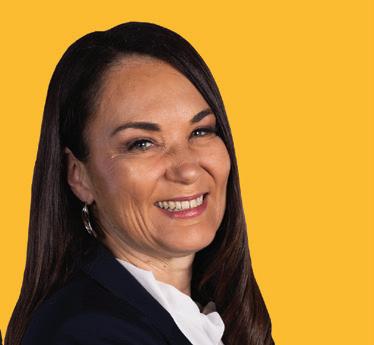NON-MAJOR BANKS ROUNDTABLE
How lenders have adjusted to a challenging market
COMMERCIAL FINANCE INSIGHTS









A comprehensive guide to business lending
TOP COMMERCIAL BROKERS 2023 Sector’s best performers revealed
ROOM TO GROW
The sky’s the limit for Pepper Money as more brokers embrace specialist lending

ISSUE 23.02
Mario Rehayem
Pepper Money












CONNECT WITH US
Got a story or suggestion, or just want to find out some more information?
CONTENTS

FEATURES NON-MAJOR BANKS ROUNDTABLE

Non-majors and brokers discuss how a collaborative approach drives their lending growth

SPECIAL REPORT
TOP COMMERCIAL BROKERS 2023



MPA presents this year’s best commercial finance brokers making waves in the industry

BIG INTERVIEW
MARIO REHAYEM


Pepper Money CEO Mario Rehayem talks about the lender’s strong partnership with brokers, who are increasingly turning to the non-bank for help with customers in specialist circumstances
twitter.com/MPAMagazineAU

facebook.com/Mortgage ProfessionalAU


UPFRONT
02 Editorial
There’s a golden opportunity for brokers to enhance customer loyalty









04 Statistics
Latest snapshot of the Australian housing market
06 Opinion
Cybersecurity should be a high priority for businesses, says AustCyber exec
FEATURES
14 Commercial property Opportunities for brokers as the sector recovers


20 SME lending
Helping businesses overcome cash flow problems
30 Asset finance

Demand for loans remains strong in certain segments
60 Business productivity
FEATURES COMMERCIAL LENDING GUIDE
The wide-ranging opportunities for mortgage brokers who break into the world of commercial lending

12 PEOPLE BROKERAGE INSIGHT

Two Birds One Loan is dedicated to helping young families achieve their financial goals
Five tips for how to use your time more e ectively at work
PEOPLE

64 Other life



Broker Misa Huynh has found her “bigger purpose” in helping the less fortunate
MPAMAGAZINE.COM.AU
NOW ONLINE:
Our daily newsletter. Keep on top of property market trends, business strategy, and what industry leaders have to say.

MAY 2023
www.mpamagazine.com.au 1
08
62
37
Golden opportunity in commercial
In a tight residential lending market, with lower borrowing capacity and fierce competition for refinancing, how can brokers grow their businesses?
The answer is by pivoting to other revenue streams – and by far and away the best option in the current market is commercial finance.
In the world of residential mortgages, brokers’ skills and product knowledge are highly valued by borrowers. The latest MFAA statistics for the December 2022 quarter show that 69.3% of all new residential home loans were facilitated by brokers.
As fantastic as this is for mortgage brokers, it means they are operating in a highly contested market. Brokers are competing not just with other brokers but also with banks that are encouraging customers to refinance with them via generous cashback o ers.
Residential mortgage brokers are also facing an uphill battle due to higher interest rates and inflation, and declining property values. This all leads to a lower appetite for loans in this sector.
Meanwhile, the opportunity for brokers to diversify into commercial lending is vast. In the six months to September 2022, only 31.8% of mortgage brokers also wrote commercial loans
In this edition, MPA features its comprehensive annual Commercial Lending Guide covering commercial property, SME lending and asset and equipment
www.mpamagazine.com.au
MAY 2023
EDITORIAL
Editor
Antony Field Writers
Mina Martin, Kim Champion
Contributors
Donna McGeorge, Jason Murrell
Lead Production Editor Roslyn Meredith
Production Editor
Allison Ingusan
ART & PRODUCTION Designers
Loiza Razon, Khaye Cortez
Customer Success Manager Isabella Concepcion
Customer Success Executive Shara Cruzat
SALES & MARKETING
Publisher Claire Tan CORPORATE
Chief Executive Officer Mike Shipley
Chief Operating Officer George Walmsley
Chief Commercial Officer
Justin Kennedy
Chief Information Officer
Colin Chan
Chief Revenue Officer Dane Taylor
Director – People and Culture Julia Bookallil
EDITORIAL ENQUIRIES
tel: +612 8437 4784 antony.field@keymedia.com
SUBSCRIPTION ENQUIRIES
tel: +61 2 8311 5831 • fax: +61 2 8437 4753 subscriptions@keymedia.com.au
ADVERTISING ENQUIRIES claire.tan@keymedia.com
KM Business Information Australia Pty Ltd tel: +61 2 8437 4700 • fax: +61 2 9439 4599 www.keymedia.com
Australia, Canada, USA, UK, NZ and Asia
finance. It provides great insights for brokers contemplating dipping their toes into this sector.
L eading banks, non-bank lenders and aggregators outline market trends in commercial finance. They explain their products and services as well as the opportunities available for brokers to expand their client bases and enhance customer loyalty by o ering a wider range of services.
Lenders also detail how their BDMs can assist brokers who are unfamiliar with commercial loans, along with the broad range of professional development and educational events they support to help brokers diversify.
This edition also features MPA’s annual Non-Major Banks Roundtable, which brings third party managers from leading non-majors and representatives of the broker sector together to discuss key industry topics. At the 2023 roundtable, the non-majors explained how they had continued to grow their home loan market share. Fixed rate roll-o s, broker partnerships and technology improvements were also on the agenda
In another issue highlight, discover who were named the Top Commercial Brokers for 2023 in MPA’s Special Report on this year’s outstanding award winners.
Antony Field, editor, MPA
MortgageProfessionalAustralia is part of an international family of B2B publications and websites for the mortgage industry
AUSTRALIAN BROKER simon.kerslake@keymedia.com
T +61 2 8437 4786
NZ ADVISER alex.knowles@keymedia.com
T +61 2 8437 4708
CANADIAN MORTGAGE PROFESSIONAL john.mackenzie@keymedia.com

T +1 416 644 8740
MORTGAGEBROKERNEWS.CA corey.bahadur@keymedia.com
T +1 416 644 8740
MORTGAGE PROFESSIONAL AMERICA katie.wolpa@keymedia.com
T +1 720 316 7423
MORTGAGE INTRODUCER (UK) matt.bond@keymedia.com
T +44 7525 456869
2 www.mpamagazine.com.au UPFRONT EDITOR’S LETTER
[There are] opportunities available for brokers to expand their client bases and enhance customer loyalty
Copyright is reserved throughout. No part of this publication can be reproduced in whole or part without the express permission of the editor. Contributions are invited, but copies of work should be kept, as the magazine can accept no responsibility for loss.






















2023 SFG NATIONAL CONFERENCE
PORT DOUGLAS
EARLY BIRDtickets
& AWARDS
INDUSTRY SNAPSHOT, APR–SEPT 2022
19,236
Number of mortgage brokers – a rise of 651 period-on-period and 951 year-on-year
HOME PRICES RISE FURTHER IN MARCH
National home prices have continued to move upwards for the third consecutive month in March, rising slightly by 0.13%. Prices increased in every capital city except Hobart, Darwin and Brisbane, with Sydney, Perth and Melbourne recording the biggest jumps.

31.8%
Proportion of mortgage brokers also writing commercial loans, up 2.8% on the prior half-year
$181,26bn
Total value of loans settled, up 9.22% from the Apr–Sept 2021 period
382,523
Total number of home loans lodged, down 3.3% from the Oct 2021–Mar 2022 period
Source: MPAAIndustryIntelligenceService15thEdition,1April2022–30September2022
A HOME IN AUSTRALIA
Despite skyrocketing rents, the proportion of suburbs where it’s cheaper to rent than buy has spiked over the past year, CoreLogic’s analysis shows. For houses, it was cheaper to buy than rent in just 9.1% of suburbs across Australia in February 2023, down from 30.2% at the same time last year. For units, it was cheaper to buy in just 16% of suburbs, down from 45.2%.
PROPORTION OF CAPITAL CITY SUBURBS WHERE IT’S CHEAPER TO RENT THAN BUY
UPFRONT 4 www.mpamagazine.com.au
STATISTICS
Source: CoreLogic, January 2023 Note: Purchase costs based on P&I interest rate of 5.23% over a 30-year loan term, assuming a 90% LVR derived from the median value. Rental costs based on median monthly rental values.
REGION MONTHLY GROWTH Sydney 0.27% Melbourne 0.12% Brisbane -0.06% Adelaide 0.1% Perth 0.24% Hobart -0.43% Darwin -0.1% ACT 0.03% Capital cities 0.16% Rest of NSW 0.16% Rest of VIC -0.16% Rest of QLD 0.11% Rest of SA 0.22% Rest of WA -0.16% Rest of TAS -0.23% Rest of NT 0.12% Regional areas 0.06% National 0.13% FEBRUARY 2022 FEBRUARY 2023 Cheaper to buy Cheaper to rent Cheaper to buy Cheaper to rent ACT 11.8% 88.2% 0% 100% Adelaide 27.6% 72.4% 1.9% 98.1% Brisbane 21.8% 78.2% 2.2% 97.8% Darwin 96.8% 3.2% 48.4% 51.6% Hobart 29.3% 39.4% 2.4% 97.6% Melbourne 0% 100% 0% 100% Perth 60.6% 39.4% 12.1% 87.9% Sydney 0% 100% 0% 100%
PROPTRACK HOME PRICE INDEX
MARCH 2023
BUILDING APPROVALS LIFT IN FEBRUARY
The total number of dwellings approved in Australia rose 4% in February, in seasonally adjusted terms, following a 27.1% fall in January, driven by an 11.3% rise in approvals for private sector houses, ABS data shows.

DWELLINGS APPROVED – KEY FEBRUARY FIGURES
WANT MORE SPACE IN A HOME
Flexible working due to the COVID-19 pandemic has changed what Western Australians think is the most desirable feature of a home, with 91% looking for more space or rooms, a Bankwest study found. The data also revealed that more women prefer working from home, and more space, than men.
MOST DESIRED FEATURES OF A HOME POST COVID-19
AUSSIE MEN STILL OWN MORE PROPERTIES THAN WOMEN
CoreLogic data shows that women still trail behind men in homeownership, with men owning 3.1% more of the housing stock analysed than women. Investments still drive the gender gap in homeownership, with men owning 7% more of the investment properties analysed than women.
PROPORTION OF HOMEOWNERSHIP BY GENDER
OWNERSHIP OF INVESTMENT PROPERTY BY GENDER
www.mpamagazine.com.au 5
Source: ABS Building Approvals, Australia, February 2023
Source: Bankwest Home Truths Report Source: CoreLogicWomen&Property,Australia2023
Female
WA Women Men Source: PropTrack Home Price Index 1
Net: more space/rooms Larger home (general) Open-plan living Dedicated study/home o ce
Male Joint male-female
April 2023
ANNUAL GROWTH CHANGE FROM PEAK CHANGE SINCE MARCH 2020 MEDIAN VALUE -6.03% -6.25% 22.8% $994,000 -5.79% -5.79% 14.4% $789,000 -2.65% -3.3% 42.6% $712,000 6.26% At peak 44.7% $650,000 3.23% At peak 30.1% $565,000 -5.16% -5.27% 40.4% $680,000 0.21% -0.56% 27% $492,000 -5.98% -5.98% 34.7% $838,000 -4.48% -4.48% 24% $783,000 -2.37% -2.87% 47.1% $708,000 -2.51% -2.81% 41.9% $597,000 0.13% -1.02% 49.3% $602,000 10.87% At peak 45.7% $381,000 4.79% -0.38% 36.9% $455,000 -0.49% -2.1% 50.6% $495,000 5.91% At peak 17.2% $454,000 -1.21% -1.87% 46.2% $615,000 -3.54% -3.54% 29.9% $732,000 26.8% 91% 89% 80% 53% 30% 47% 35% 29% 34% 20% 24% 24% 29.5% 29.9% 36.3% 43.4% 34.2% 100 80 60 40 20 0 Total dwelling units approved Private sector houses Private sector dwellings excluding houses Total dwelling units approved Private sector houses Private sector dwellings excluding houses NUMBER OF APPROVALS NUMBER OF APPROVALS SEASONALLY ADJUSTED TREND MONTHLY CHANGE MONTHLY CHANGE YEARLY CHANGE YEARLY CHANGE 12,661 8,520 3,935 13,038 8,150 4,602 4% 11.3% -9.5% -5.7% -2.9% -10.3% -31.1% -13.6% -45.7% -19.6% -17.2% -22%
Cybersecurity plan vital for businesses
FOLLOWING HIGH-PROFILE cybersecurity attacks on Latitude Financial, Medibank, Optus and others, cybercriminals are hunting for new vulnerabilities to exploit in any and all organisations.


Cybersecurity breaches rose significantly in 2022, occurring every two minutes. Some experts predict this to at least double by 2027. SMEs and financial providers are major targets for hackers, with sensitive customer data and financial information at stake. Mortgage and finance brokers, banks and brokerage networks must be especially vigilant when it comes to protecting themselves and their customers.
One of the biggest challenges facing this $5bn mortgage and finance industry is the sheer volume of data processed and stored, including personal identification and financial records. With the proliferation of Internet of Things devices and cloud-based operations, organisations must prioritise IoT and cloud security to mitigate their expanding attack surface and vulnerable infrastructures.
One of the simplest yet most essential measures businesses can take is to ensure all employees are well educated on cybersecurity best practices. This includes security measures such as strong passwords, two-factor authentication and regular software updates. These simple, cost-e ective mechanisms can prevent a cyberattacker from penetrating company defences. It isn’t enough to just implement these processes. Cybersecurity tactics must be supported by employee training so the entire workforce, not just those in IT or cybersecurity, is prepared to recognise and respond to phishing and social engineering attacks – two of the common ways that cybercriminals gain access to sensitive information.
Another critical component of a compre-
hensive cybersecurity strategy for smaller organisations is encryption. Encryption helps protect sensitive data by ensuring it’s only accessible to authorised users, even if it falls into the wrong hands. This is of particular importance when it comes to financial transactions, where even a single breach could result in significant financial loss for businesses and customers. Cybercrime was estimated to cost Australia’s economy $42bn in 2022, and the average cost per cybercrime report has risen to over $39,000 for small businesses and $88,000 for medium businesses.
Encryption represents a proactive approach to cybersecurity, ensuring data remains secure even if there’s a breach – this is essential given
Quantum computing will challenge the cybersecurity capabilities of the finance industry, requiring new strategies to defend against quantum-based threats. But while the challenges will be great, quantum can reinforce security measures. Boasting powerful encryption methods traditional computing cannot solve, quantum o ers a significant investment opportunity for financial institutions to increase the security of their data. Companies must be measured in adopting these technologies, remaining on the ball to ensure the enhancement of their cybersecurity and private data protection from increases in future attacks with the rate of technological advancements.
No cybersecurity strategy is foolproof, which is why businesses must have a comprehensive incident response plan. This includes having tried and tested protocols to ensure a swift response to a security breach, such as by notifying customers, regulators and law enforcement, as appropriate. It also means having an action plan for restoring systems and data if there’s a breach.
At AustCyber, we’re committed to working with businesses across all sectors to enhance their cybersecurity posture and protect against cyberthreats. By working together, we can
the damaging costs of a successful attack. With over 76,000 attacks reported in 2022, finance firms must build strong leadership that encourages a proactive cybersecurity approach. The goal should be to create a workplace culture that prioritises safety by remaining vigilant on the risks of cyberattacks, and embracing the safety benefits of new technologies.

The constant stream of cyberattack announcements in mainstream media can be disheartening, but as attacks increase, so do our defences. Australia is ranked the world’s fifth most powerful cyber nation, and as investment continues, this should rise. The meteoric rise of artificial intelligence and machine learning will not only help automate the process of analysing large amounts of data but also improve the ability of companies to detect and respond to cyber threats.
build a more resilient digital ecosystem better equipped to respond to evolving cyberthreats.
Cybersecurity should be viewed as an essential component of doing business in the mortgage and finance industry.
By taking a comprehensive approach to security, including educating employees, using encryption, adopting advanced threat detection tools, and having a plan to respond to security incidents, businesses in the industry will take substantial steps forward to protect themselves and their customers from cyberattackers and threats
A critical component of a comprehensive cybersecurity strategy is encryption
GOT AN OPINION THAT COUNTS? Email antony.field@keymedia.com
Jason Murrell has been a long-time supporter of Australian start-ups for the past 20 years, particularly in the cybersecurity space. AustCyber’s mission is to support the development of a vibrant and globally competitive Australian cybersecurity sector.
UPFRONT 6 www.mpamagazine.com.au
As we navigate the ever-evolving digital landscape, cybersecurity must be a high priority for businesses, says AustCyber group executive Jason Murrell
OPINION
As a 100% customer-owned bank, we always put the needs of our customers first. So, you can recommend Beyond Bank with confidence.
We take the same approach to maintaining mutually rewarding relationships with our broker partners.
• Our customer satisfaction score is 95% with our broker network.
• We offer genuine support, with open access to our Australian-based broker support team.
• Continuity of service is assured with our team owning each file from lodgement to settlement.




• Canstar Customer Owned Bank Digital Bank of the year 2022.
• Named best bank in Australia by Forbes World’s Best Banks 2022 awards.
Beyond Bank is a certified B Corp bank, we use our business as a force for good to drive positive outcomes for our people, customers, communities and planet. We commit to balancing purpose with profit by meeting the highest verified standards of social and environmental performance, accountability and transparency.






Our broker support team will work for you and with you to help your customers with their lending needs. Chat the team on 1800 029 990 or email brokerloans@beyondbank.com.au

Beyond Bank Australia Ltd ABN 15 087 651 143 AFSL/Australian Credit Licence 237 856.
MARIO REHAYEM: SKY’S THE LIMIT FOR SPECIALIST LENDING
In a tight market, more brokers are trusting Pepper Money to deliver a ‘yes’ for customers with specialist circumstances. MPA talks to CEO Mario Rehayem about its partnership with the third party channel
NON-BANK LENDER Pepper Money has enjoyed another successful year despite a market hit by rising interest rates and fierce mortgage competition.
CEO Mario Rehayem says brokers and their customers are facing two very different challenges, and the best brokers operate to a robust, ‘always on’ business model, which means they can adapt to market conditions as they change.
“When interest rates are ultra-low and there’s significant demand coming through, brokers are at the pinnacle of taking advantage of that opportunity. But when we enter into a market impacted by 10-plus consecutive rate rises, this is also an opportunity for brokers to broaden their remit of who they can help with specialist lending and shift their focus to existing customers,” Rehayem says.
“If you’ve got the recipe right, you will be busy regardless of the economic climate.”
Rehayem says that when rates are low, customers receive guidance from brokers and lenders via serviceability calculators to ensure they are not financially overcommitted. “But this is typically a point-in-time assessment of the customer’s current borrowing capacity and expenses, and then real life hits.”
Mortgage borrowers might then start to increase their liabilities through products like credit cards, which will impact their available discretionary spend.
Rehayem says Australians need to take a close look at their discretionary spending and “empower themselves by managing their finances instead of being at the mercy of their financial circumstances”.
While only a small percentage of customers are really hurting due to rate rises, he says brokers can play a meaningful and influential role. Simply asking customers questions about their expenses can prompt them to take stock of their spending habits.
Brokers need to stay in touch with their
was able to capitalise on this, resulting in the lender achieving significant growth.
“We were able to serve more customers than ever before, due to our market-leading turnaround times coupled with our creditcascading process and competitive rates,” Rehayem says. “We are obviously no different to any financial institution – our cost of funds is influenced by market conditions.”
He says now that the cost of funds has significantly increased, non-banks have had to reassess their position in terms of volume
customers and ensure they have access to the best loan products and options available at any given time. Taking extra time to show a customer all their loan options can put more money back in the borrower’s pocket, help them get the best option for their circumstances, and even be the difference between getting an approval and delivering a ‘no’.
Over the past 18 months, the cost of funds was at an all-time low, and Pepper Money
versus margin. Even some major banks are struggling to grow due to strong competition and cashback offers.
“Time will reveal that these cashback strategies are not sustainable; sooner or later, it will come to an end.”
Once it ends, banks will increase their deposit rates and further increase home loan rates. “This will see the resurgence of nonbanks being much more competitive than
8 www.mpamagazine.com.au
BIG INTERVIEW PEOPLE
“The beauty of specialist lending is we make it our role to understand the customer situation and not adopt a ‘computer says no’ mentality. We understand that real life happens”
PROFILE
Name: Mario Rehayem
Title: CEO
Company: Pepper Money
Years in the industry: 22
Favourite quote: “Acoffinhasnopockets –allyouhaveisyourname;makesureit’s agoodone. The author of that is my mum. It means you’re not taking anything with you, but what will always be remembered is your name and what you stood for. Make sure you are remembered for all the right reasons.”
Highlight of working at Pepper Money:
“It’s all about our people. I was very fortunate early on in my career being surrounded by great mentors that supported me. Watching the many individuals in our business grow, evolve and move up the ranks is the most rewarding aspect of my role. The culture we have developed at Pepper Money is second to none.”

www.mpamagazine.com.au 9
BIG INTERVIEW
they’ve been in the last six months.”
Pepper Money’s advantage is that “we push our own boundaries to keep creating financial inclusion in every way we can, by pivoting to the market conditions and delivering what customers need”, Rehayem says.
“We want to ensure our mission of helping people succeed is synonymous across everything we do – in technology, product design, customer service and more. We continuously improve the experiences we o er and maximise the best possible outcome for our brokers and their customers. That’s very hard for the big banks to replicate due to the diverse loan options that we o er.”
Rehayem says Pepper Money has consistently pushed the envelope with regard to
Borrowers who have struggled to cope with rising interest rates and quickly readjust their spending might miss a few repayments, he says. Unlike banks that can decline loan applications based on one missed repayment, Pepper Money assesses the customer’s situation carefully and holistically.
“The beauty of specialist lending is we make it our role to understand the customer situation and not adopt a ‘computer says no’ mentality. We understand that real life happens,” Rehayem says.
Commercial real estate loans are a hot commodity for Pepper Money at present. “We have seen a significant increase in applications and volume in this space.”
To assist brokers who are unfamiliar with CRE loans, Rehayem says Pepper Money has
PEPPER MONEY HIGHLIGHTS
April 2023
Pepper Money pioneers a xed interest rate loan with a competitive rate and no break costs
March 2023
Named WeMoney Non-conforming Lender of the Year
February 2023
Removes commercial mortgage clawbacks
January 2023
West Tigers sign with Pepper Money as Coaches Partner 2023
December 2022
Awarded KangaNewsAustralian Non-Bank Financial Issuer of the Year
October 2022
Recognised as one of the AFR BOSS Top 10 Most Innovative Companies 2022
August 2022
products that satisfy the real-life needs of real customers, filling a void left by banks with their “cookie-cutter approach”.
Pepper Money is a “market leader” in the non-conforming mortgage space, he says, but it also has a diverse range of lending options across prime, near prime, specialist, commercial real estate and asset finance.
“When the market softens and loan volume decreases, many brokers look to diversify their businesses. They’ll look to serve di erent borrower segments, such as those with a life event or debt consolidation. Brokers will also look at asset finance and car loans.
“Year to date, we have experienced a significant increase in the number of brokers that have submitted a loan to Pepper Money for the first time.”
While Pepper Money originates more loans than any other non-bank, there’s still room to grow. “We don’t believe we’ve hit that ceiling,” Rehayem says.
made the submission process almost identical to submitting a residential loan.
“We’ve also seen a significant increase in refinancing, and many customers actually have a good portfolio of commercial properties. They’ve come to Pepper Money to refinance or get cash out to grow their commercial or residential portfolios.”
Rehayem says more mortgage brokers are diversifying into commercial real estate and turning to Pepper Money because it has “stripped away the complexity”.
Over the next 12 months, Pepper Money will continue to focus on product innovation. The non-bank recently pioneered a new mortgage option in the Australian market: a fixed rate product with no break costs. “That’s the first of more innovative products to come.”
Around 40% of Pepper Money customers are self-employed, and the non-bank lender will introduce fully automated documentation processes for them, Rehayem says.
Evie Networks and Pepper Money partner to give a year’s worth of free EV charging to customers who make the switch to electric
Another focus is on technology to improve post-settlement servicing, including self-help options for customers to manage their loans.
“Chatbots are becoming a feature in every industry. Real-time broker support is here, as we recently launched our Broker Assist chatbot to direct brokers to the answers they need,” Rehayam says. “We also want to ramp up education and confidence of brokers in the non-bank space. We’re invested in making it easy to do business with us, to make sure brokers maximise every customer interaction they have.
“If you haven’t done it, try us. Don’t assume you know where our boundaries are. If you have a customer that doesn’t tick the boxes for whatever reason, give it the non-bank test. If Pepper Money can help, we will.”
PEOPLE 10 www.mpamagazine.com.au
“Year to date, we have experienced a significant increase in the number of brokers that have submitted a loan to Pepper Money for the first time”













































































































Compare multiple quotes Protect your business instantly Save time and money *Must be a Qantas Business Rewards member. Maximum of 10,000 Qantas Points earned per policy. Available to new BizCover policy purchase only and not available with any other offer. See Terms & Conditions at bizcover.com.au/qbr The information provided is general only and should not be relied upon as advice. BizCover Pty Ltd (ABN 68 127 707 975; AFSL 501769) © 2023 BizCover. BC2449 bizcover.com.au 1300 805 821 Earn Qantas Points for every dollar spent on a new small business insurance policy SCAN TO COMPARE QUOTES
NEW OPPORTUNITIES FOR THE TAKING






FEATURES COMMERCIAL LENDING GUIDE 12 www.mpamagazine.com.au
Brokers focusing purely on the home loan market are grappling with intense competition for customers, with almost 70% of residential mortgages facilitated by brokers. But the competition doesn’t just come from fellow brokers; the banks are also trying to lure in new clients with aggressive cashback o ers.
While refinancing activity is still strong, loan volumes have declined. Major aggregator AFG reported a 3.3% decrease in lodgement volume for the third quarter of FY23 – a drop of 11.67% compared to the same period a year prior.
After nearly a year of rising interest rates and higher inflation, fewer people are taking out home loans, borrowing capacity is lower, and the average loan size has also fallen. So, in a challenging market, how can ‘the tough get going’ if they run a brokerage and want sustainable growth – and to not have to rely on just one customer segment?
The answer is, of course, commercial finance, which compared to residential lending remains a sector largely untapped by brokers.
The 15th edition of the MFAA Industry Intelligence Service report, covering the six months from 1 April 2022 to 30 September 2022, shows that the proportion of mortgage brokers writing commercial loans



during that period stood at just 31.8%. While the percentage was higher than in the previous six months (29%), and for the first time there were more than 6,000 mortgage brokers writing commercial loans, there’s still a massive opportunity for brokers to take advantage of what the commercial market has to o er.
Small to medium-sized businesses have continued to show resilience, bouncing back from the COVID-19 pandemic. They are now trying to deal with challenges brought about by inflation – the rising cost of doing business – but also supply chain problems, lack of skilled labour, and growing wage bills.
SMEs are looking for finance options to solve cash flow problems and consolidate debt, and of course, when the economy picks up they’ll need capital to grow. Their best bet is to turn to a broker to help them navigate the vast network of lenders and products to find loan options that suit their circumstances.
In MPA’s Commercial Lending Guide, industry leaders discuss three important sectors: commercial property, SME lending, and asset and equipment finance. They outline the benefits of broker diversification and the loan products and services that are available, and debunk the myth that commercial finance is too complex for mortgage brokers. They also provide insights into market trends and what’s ahead for commercial finance over the coming year.
www.mpamagazine.com.au 13
IT’S AN old cliché, but the saying ‘when the going gets tough, the tough get going’ is apt in the world of lending.
How can residential mortgage brokers break into the world of business lending? Commercial finance o ers a less crowded and competitive marketplace than home loans, enabling brokers to expand their client bases and boost their value proposition.
MPA’s Commercial Lending Guide provides a comprehensive look at what the sector has to o er
Capitalising on a growth industry
AUSTRALIA’S COMMERCIAL property sector has been hit by a series of challenges. Rising interest rates and inflation, labour shortages, supply chain problems and the collapse of construction companies have all had a major impact. But there are new opportunities available.
Monthly business finance figures from the ABS provide an indicator of the appetite for commercial property finance. Its January 2023 data shows loan commitments for construction finance fell 2.5%, but the overall trend was flat, while commitments for the purchase of property fell 0.7% and in trend terms were down 1.7%. In February, construction finance loan commitments rose 62.2% –in trend terms an increase of 1.1% – while property purchase commitments fell 2%, a dip of 1.1% in trend terms.
Herron Todd White’s Month in Review report showed that industrial assets worth less than $10m performed strongly in February, particularly in the owneroccupier market. Inflation also improved, falling to 6.8% in February, down from 7.4% in January.

Some economists predict rate hikes will soon end. As supply chain issues also improve, inflation eases and immigration levels recover, opportunities will arise in the commercial property market.
La Trobe Financial chief lending officer Cory Bannister, Gateway Bank chief operating officer Zeb Drummond, NAB Commercial Broker head of specialised and private Anita Hyde, and ANZ associate director – property Daniel Gradwell provide their insights into the sector.
Market challenges
Gradwell says the construction sector continues to struggle with cost pressures, and several high-profile companies have collapsed.
“It’s not just material costs driving these pressures, as an incredibly tight labour market makes staffing difficult and expensive to obtain,” he says.
Lenders explain how brokers can make the most of demand for commercial property finance – a sector that’s on the road to recovery – especially when it comes to industrial assets
COMMERCIAL PROPERTY FEATURES COMMERCIAL LENDING GUIDE 14 www.mpamagazine.com.au
“We are increasingly hearing reports that construction costs are now starting to flatten out, but we don’t expect costs to go back to where they were a few years ago, given the huge pipeline of work under construction across the residential, commercial and infrastructure sectors.”
Gradwell says it appears that the ratehiking cycle is nearing its peak. “This is likely to provide some confidence to individuals and businesses after a very turbulent period, which will only help the commercial property segment.”

Drummond says Gateway Bank’s product offering is in the under-$10m space and the bank is seeing trends that are consistent with the market.
“Clearly the last 12 months have been challenging as inflation, cost of living pressures and an increasing-rate environment have dampened consumer sentiment, which obviously flows through to our commercial sector,” he says.
Inflation easing in February gave rise to optimism that “we’ve hit peak inflation”, he says, but there’s still a long way to go before central banks will be confident that they have it under control.
“Consumer sentiment is a key driver of the economy,” Drummond says, “and we’re still sitting at historically low levels.”
Once interest rates stabilise, he believes sentiment should improve, which will be a positive for both residential and commercial property.
Hyde says that because those who acquire commercial real estate are business owners or sophisticated investors, NAB looks at economic signals such as the NAB monthly business survey, which is a good indicator of business confidence and conditions.
“What’s really positive from these surveys is the ongoing resilience we are seeing from Australian businesses,” she says. “While the headwinds are real, there are still many businesses looking to expand and take advantage of opportunities as they arise.”
NAB’s Commercial Property Survey, released on 23 March, shows that property professionals are facing tougher conditions because of higher interest rates, and they expect these to persist over the next three to six months.
Growth areas
Bannister says La Trobe Financial’s SMSF product has been one of its most popular loans for several years, and as more Australians opt to invest their superannuation in real estate, an investment in a commercial property could help diversify a borrower’s portfolio.
“Bringing to the customer’s attention the benefits of commercial property investment – whether SMSF or otherwise – could help open a door to possibilities for both brokers and their clients,” he says.
La Trobe Financial also encourages brokers to become familiar with and use non-banks.
office, making them more resilient to external factors and ultimately more profitable.”
Hyde says the NAB Commercial Property Index shows that sentiment has improved and remains positive for industrial property, which continues to experience boom conditions, sitting at +44 points, up from +41 points in Q3. Industrial property is forecast to outperform the broader market in the next one to two years.
“As Australian businesses continue to strengthen their supply chains following recent disruptions caused by the pandemic, this property sector remains attractive to business owners needing more warehouse or logistical capacity,” Hyde says.
She says ongoing work-from-home trends continue to be an obstacle for CBD office and retail property, but “there are still selected opportunities with more office space expected to be needed in all states in the next 12 months”.
“Considering a partnership with nonbanks is mutually beneficial to non-banks and brokers alike, especially when it comes to obtaining finance in complex situations, or lending products secured by commercial properties,” Bannister says.
Brokers who expand their knowledge of the wide range of products and policies on the market can diversify their clientele. “This, paired with becoming more familiar with commercial property, will bolster a broker’s
Development activity should pick up in the second half of 2023 and into 2024, particularly as immigration levels rise to alleviate labour shortages. Hyde says this will likely fuel demand, especially due to a shortage of rental property. As building input costs moderate, developers will gain confidence about their profit margins.
“Brokers have an opportunity to establish strong networks now with developers and project managers to be brought in as part
www.mpamagazine.com.au 15
“Bringing to the customer’s attention the benefits of commercial property investment, whether SMSF or otherwise, could help open a door to possibilities for both brokers and their clients”
Cory Bannister, La Trobe Financial
COMMERCIAL LENDING GUIDE
scenarios, the similarities become far clearer than the di erences.”
Gateway supports brokers through its flexible and simple products; technology o ering, such as ApplyOnline for loan applications; and relationship management. It o ers 30-year loan terms, no annual reviews, and online account management.
“We have an experienced and dedicated commercial lending manager who can work through scenarios and workshop deals to ensure that we’re able to support brokers and their clients,” Drummond says.
of development transactions from the beginning,” she says.
Drummond says there’s growth in the under-$10m segment, particularly industrial units. He adds that challenging economic conditions often provide growth opportunities as property price increases slow down or reverse because opportunistic, cashed-up buyers take advantage of the market to expand their portfolios.
“We’re facing challenging economic circumstances over the coming 12 months, particularly in the residential property market,” he says. “These challenges provide brokers with an opportunity to diversify their business models and grow their penetration in commercial lending.”
Gradwell says ANZ Commercial continues to see commercial property performance being shaped by household spending. He says industrial property is still red hot as consumer spending remains strong, especially online shopping, which is driving demand for storage and warehouse facilities.
“We’re also seeing strong growth in suburban shopping centres as people spend more time and money closer to home, although this is coming at the expense of CBD retail assets, which continue to struggle.”
With more people working from home, Gradwell says there is a clear “flight to quality” in the o ce space, with companies requiring well-located assets with good amenities to attract workers back to the o ce.
Broker education and support
Drummond says the core skills of building a commercial lending portfolio are not significantly di erent to the skills required to build a successful residential portfolio. Key skills involve brokers keeping close to their clients and providing quality service and engagement.
“Commercial loans do have more complexity than your traditional residential lending,” he says. “However, once a broker has worked through a few commercial

Hyde says brokers can access a range of industry-specific insights, research and networking events, such as NAB’s Quarterly Commercial Property Webinars and Commercial Property Survey, which provide information on market trends and help brokers deepen their industry knowledge.
“Understanding the context in which businesses are operating helps brokers to form deeper relationships with their customers and provide solutions better
16 www.mpamagazine.com.au FEATURES
NEW BUSINESS LOAN COMMITMENTS BY PURPOSE 10 8 6 4 2 0 Feb 05 Feb 23 Feb 20 Feb 17 Feb 14 Feb 08 Feb 11 Construction (seasonally adjusted) Purchase of property (seasonally adjusted) Construction (trend) Purchase of property (trend) $bn
“We have an experienced and dedicated commercial lending manager who can work through scenarios and workshop deals to ensure that we’re able to support brokers and their clients”
Source: ABS Lending Indicators, February 2023
Zeb Drummond, Gateway Bank




















Get in touch 1300 302 474 gatewaybank.com.au/broker Applications for finance are subject to our standard credit assessment criteria. Full T&Cs are included in the loan offer. Fees and charges apply. Gateway Bank Limited | ABN 47 087 650 093 | AFSL / Australian Credit Licence Number 238293 Commercial Mortgages Competitive, flexible lending solutions for business owners and investors. Loans from $250k to $10 million 30-year loan terms Flexible features No annual reviews Help your clients purchase, expand or refinance their existing commercial property. Help your clients manage their business or investment with certainty. Help your clients manage their cashflow when compared with shorter loan term options. Help your clients access unlimited additional repayments, and redraw to ensure they can draw on funds when they need them.
COMMERCIAL LENDING GUIDE
tailored to their customers’ needs,” she says.
KEY OPPORTUNITIES FOR COMMERCIAL PROPERTY IN 2023

Brokers should start conversations with clients and lenders early on so they can manage their clients’ needs and expectations versus lender appetites. Hyde says NAB’s team of specialised BDMs can help brokers ask the right questions and ensure the transaction is presented in the best way to achieve the optimal outcome.
Complete CBD revival
The resurgence of CBD markets is gathering momentum due to residents and workers seeking shortened commute times and more e ective in-person interactions. This is set to reignite demand for prime CBD o ce locations.
“Brokers working specifically in commercial property need to ensure they understand financial feasibility and can weigh up the risk associated with proposed developments to ensure successful outcomes … we can support
brokers by ensuring ease of use, including a single online application form that applies to all loan products.
“We don’t make brokers jump through any additional, laborious hoops to begin writing commercial loans,” he says.
“A broker that has partnered with a major aggregator is automatically accredited to write all of our loan products, which includes residential, commercial, SMSF, construction and development.”
Credit-skilled BDMs also guide brokers through the process if it’s new to them, Bannister says.
Easing construction costs
Construction costs are set to decrease by 10–15% as raw material costs and better availability of labour returns to Australia.
Surge in demand for premium assets
Talent attraction and employee wellness incentives are key drivers of CBD occupiers upgrading their premises and favouring quality o ces with the same or higher market rents. Source: CBRE Asia-Paci
brokers and their clients with a full suite of products and assist brokers with structuring and scenarios.”



Bannister says La Trobe Financial’s recent national workshop tours have been hugely successful, and all brokers are invited to attend future events.
The non-bank’s BDM team is experienced in commercial lending and development finance, and well placed to handle the “curliest of questions”, he says.
“With our BDMs supported by one of the largest credit teams in the non-bank sector, you’re in good hands to begin learning about, and then writing, commercial loans with La Trobe Financial.”
Bannister says La Trobe Financial assists
Gradwell says ANZ Commercial values its ongoing relationship with its broker network.
“Once a broker is commercially accredited with us, we will support the broker by giving them access to specialist lenders who can work with them on transactions. We will also work with a broker from the time of application and are here to assist them throughout the life of the customer’s loan with ANZ.”
Brokers are encouraged to take part in ANZ broker education webinars, but ANZ also regularly presents webinars that go beyond policy and product information, such as specialist property lending webinars featuring case studies to help bring complex commercial property lending scenarios to life.
c Real Estate Market Outlook, February 2023
“As Australian businesses continue to strengthen their supply chains following recent disruptions caused by the pandemic, industrial property remains attractive to business owners needing more warehouse or logistical capacity”
FEATURES
Anita Hyde, NAB Commercial Broker
18 www.mpamagazine.com.au
ANZ grew its broker manager and banker workforce in 2022, boosting support for the broker channel. Broker managers regularly visit broker offices, allowing brokers to discuss lending opportunities or get updates on commercial property.
Client generation and referrals
Hyde says commercial property is about long-standing relationships; the best referral partners are existing clients who can open up their networks of family and business associates contemplating buying a commercial property.
Brokers should focus on attracting clients who have demonstrated long-term success with investing and/or running development projects to time and budget.
“Talking to existing commercial property customers and trading businesses to really understand their needs is imperative to building your network,” Hyde says.
“Commercial property transactions have long lead times, so it’s important to understand your client’s plans for the next 12 to 24 months and ensure you are standing there next to them when the time comes.”
Gradwell says a great place for brokers to start is by looking at their mortgage customer bases, identifying those who are business owners and talking to them about their business needs.
They should ask customers if they are looking to grow their businesses and need new operating premises, he says. “Or do you have clients who are looking at investment opportunities and see commercial property
as an opportunity worth exploring?”
Brokers can ask existing clients if they can refer a friend, and also connect with accounting firms and property valuers, Gradwell says.
La Trobe Financial firmly believes that brokers who partner with a wide range of professionals, such as accountants, financial planners and real estate agents, are best placed to perform well, Bannister says.
“We have a loan for every life stage – from a full-doc first home buyer to SMSF loans and loans to assist property developers with their residual stock,” he says.
“If a broker is to take the same mindset of having a breadth of solutions in the market for all borrower and security types, they’ll find it beneficial for their value proposition.”
Drummond says there are two key ways for brokers to generate new commercial property clients: by leveraging existing clients looking to diversify their investment portfolios and revenue streams; and by building strong referral networks.
“Accountancy firms, legal firms and real estate agents all offer strong referral opportunities,” he says.
“If you have strong residential referral partners, these could be leveraged to provide strong commercial opportunities.”

www.mpamagazine.com.au 19
“There is a clear flight to quality in the office space, with companies requiring well-located assets with good amenities to attract workers back to the office”
NATIONAL CONSTRUCTION ACTIVITY – INDUSTRIAL AND LOGISTICS MARKET 3,000 2,500 2,000 1,500 1,000 500 0 SQM (000’S) 2012 2013 2014 2015 2016 2017 2018 2019 2020 2021 2022 2023 2024 2025 Completed Plans approved Under construction Source: JLL Research, Q4 2022
Daniel Gradwell, ANZ
SME LENDING
Brokers can help solve cash flow crunch
Lenders have plenty of options on the table to help brokers and their small to medium-sized business clients overcome cash flow problems and prepare for growth when the economy picks up

IT’S A challenging time right now for business owners. Following a rise in consumer demand and confidence last year as the economy bounced back from the pandemic, a new reality has set in – people are not spending as much.
This is due to more of their income being taken up by higher interest rates, driven by 11 increases in the o cial cash rate as at time of printing.
The impact on the economy cannot be understated, with the vast majority of mortgage holders in Australia on variable home loan rates. Many are paying rates of 5% plus, a far cry from the sub-2% rates of a little over a year ago.
This falling consumer demand –combined with inflation sitting at 7%, labour shortages and supply chain problems – has hit many SMEs hard. The CreditorWatch Business Risk Index for February 2023 shows that business conditions have tightened, particularly around payment times, due to high inflation and interest rates along with falling demand. Trade payment defaults are up 30% yearon-year, while B2B trade receivables are down 10% year-on-year.
Cash flow is di cult for SMEs when trading conditions are tough, but savvy brokers know there are lenders in the market
that understand how businesses operate and can provide tailored finance products to assist them through challenging times.
MPA gauged the views of some leading SME lenders to get a further understanding of the market and insights into how brokers can help provide debt solutions to smooth out
business cash flow and aid growth. We spoke to ING Australia national sales manager commercial John Kolyvas, Grow Finance co-CEOs David Verschoor and Greg Woszczalski, Aquamore head of distribution Matthew Porch, and Thinktank general manager partnerships and distribution Peter Vala.
20 www.mpamagazine.com.au FEATURES COMMERCIAL LENDING GUIDE


















COMMERCIAL LENDING GUIDE
Market trends
Porch says Australian SMEs contribute to a large majority of the country’s GDP.

“Whilst at a macroeconomic level the sentiment is bleak, in reality things aren’t as bad as the mainstream media portray,” he says.
“Unemployment is still relatively low at 3.5%, but this has inflationary pressures, which are not letting up as fast as the Reserve Bank would like with their rate increases.
“Inflation and higher rates are squeezing SMEs, and employees are demanding pay rises, hurting cash flow. Businesses need to manage this cash flow. Tailored, structured lending can assist with working capital management. Prudent, diligent brokers are well placed to help SMEs navigate through this period of adjustment.”
In terms of business confidence improving, Porch says it’s a waiting game right now.
“Spending needs to drop o to cool inflation, but once spending eases, sales will be hit. It’s therefore a balancing act, and many cost reductions need to be realised for SMEs to trade profitably.”
However, Porch says some sectors are currently booming, such as domestic manu-
facturing, transport and logistics and civil construction.
Kolyvas says many business owners are being savvy about how they manage the current economic climate.
“Some are reviewing their market, clients, suppliers and how they run their business on

“Checking in with your customers will allow you to pick up on early warning signals. As part of this, the broker should be encouraging their SME customers to get help from their accountants and banks as soon as possible – even facilitating this with the customer’s blessing.”
a regular basis,” he says. “They’re also staying ahead of the curve by leaning on their key advisers proactively – like accountants and brokers – making tough decisions as early as possible.”
He says just as brokers do regular health checks on their customers’ home loans, they should be doing the same for their SME customers’ business loans.
Current uncertainty about interest rates will be contributing to SME customers’ stress levels, but Kolyvas says once rates stabilise business confidence should improve.
Verschoor and Woszczalski say that in general, SME owners have become more proactive in seeking alternative financing solutions to help future-proof their businesses and maintain margins.
“Supply chain issues have resulted in increased demand for funding of used equipment,” Verschoor says. “This is especially prevalent in the manufacturing sector.”
The CEOs say it’s important for brokers to understand their clients’ needs and work closely with lenders to present viable longterm options that avoid boxing customers into high-interest, inflexible products and terms.
Vala says the challenging economic conditions have certainly impacted SMEs and the self-employed (both negatively and positively), depending on their type of business and location.
“The need to either shore up operating costs or free up cash to take advantage of opportunities has seen an increase in requests for debt consolidation to reduce monthly repayments and improve cash flow,” he says.
“This is when a trusted broker becomes an
22 www.mpamagazine.com.au FEATURES
“Aquamore’s assessment criteria are simple and clear, using judgmental credit principles to assist clients who may not fit mainstream lenders’ rigid policies”
Matthew Porch, Aquamore












COMMERCIAL LENDING GUIDE
requirements. “Critically, these loans are mostly o ered over longer terms, allowing SME customers to manage their cash flow better.”
Grow provides SMEs with quick, easy access to capital to support growth and more e cient operation of their businesses, Verschoor says. As a non-bank lender, Grow can provide customers with multiple debt solutions very quickly.

“All of Grow’s products are designed to help businesses with their working capital and cash flow requirements,” Verschoor says.
“The company has a healthy appetite for new, used and obscure equipment, in addition to our overdraft facility, which provides the flexibility to make interest-only payments versus the principal and interest o ered by many of our competitors.”
a way forward to obtain finance.
“Thinktank loans are available for refinance, restructuring, consolidation and equity release – apart from SMSF – to aid freeing up important cash flow,” Vala says.

The non-bank lender also o ers a line of credit, which is an option with both full-doc and mid-doc loan products. With this option, there are no line or unused facility fees, Vala says, and it provides an ideal standby facility of up to $500,000 for approved borrowers.
“With our 30-year terms, set-and-forget facilities and ability to borrow up to $4m against commercial property security, every aspect of our o ering is geared towards helping the borrower take control or take advantage of their current financial position and longer-term wealth objectives.”
important ally for a business owner to source the most e ective lending solution, which is often a non-bank alternative o ering maximum flexibility.”
Thinktank’s 30-year loan terms and setand-forget facilities allow borrowers to free up cash flow, while also providing peace of mind and certainty because there’s no need for ongoing covenant reporting and revaluation requirements, says Vala.
“The most important factor in all of this is for the broker and lender to work closely together to provide current and comprehensive solutions for the SME that respond e ciently and e ectively to the changing market conditions.”
Business fi nance solutions
Kolyvas says ING o ers set-and-forget secured commercial loans that SME owners can use to invest in their businesses or for working capital
Vala says all of Thinktank’s lending solutions are designed for flexibility and hasslefree borrowing. “Both these factors have been crucial and desirable for SMEs and the selfemployed during recent years.”
Thinktank has seen a significant uptake of its mid-doc loans, which only require a selfcertified income declaration and one other form of documentation (accountant’s letter, last two BAS, or six months’ bank statements) to support current income for serviceability.
Vala explains that this o ers businesses with volatility in their trading performance, as a result of circumstances such as COVID,
At Aquamore, Porch says the private lender provides flexible finance solutions designed to assist SMEs through leverage against property assets.
“Aquamore’s debt solutions are for business purposes and are structured via a fully drawn advance,” he says.
Businesses can access from $300,000 to $5m via full-doc, alt-doc or no-doc products for up to 36 months, with the option to extend this term.
“The assessment criteria are simple and clear, using judgmental credit principles to assist clients who may not fit mainstream
24 www.mpamagazine.com.au FEATURES
“Brokers who provide additional services create the opportunity to add more value to existing customers and attract new clientele, which, when properly managed, increases customer retention and brokerage revenue”
INCREASING PROPORTION OF MORTGAGE BROKERS WRITING COMMERCIAL LOANS Source: MFAAIndustryIntelligenceService15thEdition, April–September 2022 2.8% Apr 22–Sept 22 Oct 21–Mar 22 29% 31.8%
David Verschoor and Greg Woszczalski, Grow Finance





COMMERCIAL LENDING GUIDE
lenders’ rigid policies. In addition, clients can reduce their debt without penalty at any time throughout their facility on serviced loan options.”
Support, education for brokers
Woszczalski says Grow has established a specialist team dedicated to supporting and educating mortgage brokers and other professional service providers who are diversifying their product offerings.
“We have a BDM presence in all states,” he says. “Each BDM has a designated account manager to enhance efficiencies. The Grow relationship management team works closely with the broker, whether in person, on the phone or online.”
brokers can implement to support their client base,” Porch says. “The company also collaborates with various non-bank lenders to host in-person and online events promoting market, category, scenario and product awareness.
“We also spearhead industry webinars, such as the recent Commercial Finance Market Update panel event in conjunction with Lumi, Accendo Financial and a specialist commercial broker, that provided brokers insights on the economy, market trends and where we see things headed in the near future.”
Porch says Aquamore hosts broker education sessions highlighting topics such as spotting opportunities, managing conver-

aggregator partners to deliver ongoing programs ranging from group sessions held in person or via webinar through to one-oneone workshops,” he says.
These can include sessions covering simple property-based commercial lending solutions as well as the concepts of more difficult cash flow lending structures. Thinktank also provides tools to help identify, and then convert, lending opportunities and the many ways brokers can assist SMEs, the selfemployed and their referral partners.
Vala says that while remote delivery has a significant role to play, face-to-face sessions offer the most effective and valuable learning outcomes. “We encourage any broker looking to understand more about commercial lending or even just to workshop client scenarios to reach out to their aggregators or speak directly to one of our Thinktank team to come along to one of our upcoming courses.”
Kolyvas says ING’s commercial loan process has been developed to mirror its home loan process, and the bank’s BDMs and sales support staff are used to dealing with brokers who have less experience with processing commercial loans.
“Rather than asking the broker to introduce the client only, ING prefers to have the broker manage the client relationship and stay involved in the end-to-end process,” he says.
High-touch BDM support is backed by Grow’s highly sophisticated technology, which is intuitive, automated and expedites the loan application process, Woszczalski says. In addition, the company provides regular product training and spearheads education initiatives.
“Brokers are also provided with access to our online portal, where they can easily create quotations and actively manage applications.”
Aquamore hosts regular education workshops and seminars to upskill brokers on commercial lending.
“This includes how to spot opportunities, along with helping implement strategies
sations with business clients, and structuring an approach designed to leverage potential clients in the non-coded space.
“This is particularly helpful for brokers who are used to dealing with coded residential mortgage lending only and may be unsure how to diversify into commercial finance.”
Vala says Thintank’s support for the broker channel comes in many forms and is driven first and foremost by dedicated relationship managers who are there with the broker from initial workshopping of a deal through to settlement.
“From an educational perspective, we regularly work in conjunction with our
“Our assessors also talk to the broker once the application is received. This ultimately gives the broker a much better understanding of the decision early on, resulting in a better outcome for all parties.”
Diversification opportunities
MFAA statistics for the December 2022 quarter show that brokers facilitated 69.3% of all residential home loans. However, for the six-month period between April and September 2022, only 31.8% of mortgage brokers also wrote commercial loans.
While the percentage of brokers working in commercial finance is improving, up
“The need to either shore up operating costs or free up cash to take advantage of opportunities has seen an increase in requests for debt consolidation to reduce monthly repayments and improve cash flow”
FEATURES
Peter Vala, Thinktank
26 www.mpamagazine.com.au
2.8% on the six months to March 2022, there’s massive scope for growth in an underutilised market, especially considering the intense competition in home mortgages.
Vala says with challenging market conditions expected to persist, borrowers are increasingly re-evaluating their financial positions to improve cash flow.
“Brokers who have close relationships with their clients can make the most of these opportunities, particularly where they have the skills to support alternative lending and debt restructuring options. Now is a great time to act,” he says.
Diversification into commercial helps provide more comprehensive financial solutions for borrowers, Vala says, serving to deepen relationships by giving clients the
enhanced lending support they need in everchanging times.
“Borrowers do not want or have the time to retell and share their story with multiple brokers or lenders,” he says. “So brokers who can meet both the residential and commercial needs of their clients with a broad range of product offerings are in a strong position to not just protect their loan book from competition but expand it.”
Vala says diversification also enables brokers to have a consistent income in a fluctuating market, such as when the residential sector and parts of the commercial market are behaving in the countercyclical manner we are seeing now.
“The old line is unchanged: if a broker is not writing the commercial loan, someone
else is, which means they may end up losing the existing home loan and connection with the client,” he says.
“Why take this risk when the move to diversifying into commercial is a genuinely easy transition to make?”
Porch says, “Diversification is key to managing concentration risk. This is especially the case now.”
Being skilled at commercial lending enables brokers to adopt a whole-of-wallet approach, managing all aspects of their clients’ requirements, Porch says. “This creates ‘stickier’ clients and additional revenue streams.”
Kolyvas says the residential property market, commercial property market and small business demand are all independent of each other. “This means that when the
www.mpamagazine.com.au 27
Jan 21 Jan 22 Feb 21 Feb 22 Mar 21 Mar 22 Apr 21 Apr 22 May 21 May 22 Jun 21 Jun 22 Jul 21 Jul 22 Aug 21 Aug 22 Sep 21 Sep 22 Nov 21 Nov 22 Jan 23 Dec 21 Dec 22 Feb 23 Oct 21 Oct 22 1,400 1,200 1,000 800 600 400 200 0
YEAR-ON-YEAR RISE IN NUMBER OF B2B TRADE PAYMENT DEFAULTS
Source: CreditorWatch Business Risk Index, February 2023
COMMERCIAL LENDING GUIDE
residential market is subdued, the commercial property market and SME sentiment may be stable – or vice versa. Most brokers that are home loan focused may already have a solid base of SME customers.”
Diversifying into SME lending helps a broker retain their SME customers, says Kolyvas. “Business owners have more regular needs for finance and more complex needs as well. This facilitates deeper relationships with less focus on just interest rates. Furthermore, o ering more services allows brokers to also balance and protect their own business and cash flow.”
Verschoor and Woszczalski say brokers who o er additional services can provide more value to existing customers and also attract new clients. When properly managed, this increases customer retention and brokerage revenue.
Looking ahead
Woszczalski says that historically, Australian SMEs have proven to be resilient through challenging periods, and while some industries are expected to face greater headwinds, others will flourish.
“Grow expects continued strong demand for business loans, overdraft facilities and asset finance via non-bank lenders as banks tighten credit lending requirements and SMEs focus more and more on their bottom line and look for ways to improve cash flow,” Woszczalski says.
Porch says the well-established businesses and experienced operators that have been through peaks and troughs before, and have borrowed diligently and put money aside to assist with cash flow challenges, are expected to move through this market volatility.
“Conversely, we expect to see mergers and acquisitions increasing as some operators seek to cash out or cut their losses,” Porch says.
Vala says that due to various structural factors, commercial property-secured loan rates are typically a bit higher than they are for residential property loans, but it’s impor-

PLANNED SMALL BUSINESS ACTIVITY IN AUSTRALIA OVER NEXT 12 MONTHS
tant to note that rates are still within the 1990–2023 average historical range.
“While the next 12 months will still see di culties amid supply chain issues, higher interest rates and labour shortages, we remain positive that these areas will continue to improve over time and in turn support continued growth in the economy,” he says.
For brokers and their SME or self-
employed clients, Vala says it’s about positioning a business to take advantage of changes as they occur.
“A key aspect of this is ensuring su cient liquidity and cash flow is available to meet current and future commitments and any finance is structured to smooth out and support the business through any unforeseen events with the flexibility to adapt accordingly.”
28 www.mpamagazine.com.au FEATURES
“Diversifying into SME lending helps a broker retain their SME customers. Business owners have more regular needs for finance and more complex needs as well. This facilitates deeper relationships”
John Kolyvas, ING Australia
2019 2020 2021 2022 2023 Expect to increase employee numbers 14.5% 10.6% 13.0% 19.2% 27.8% Will introduce a new product, service or process unique to their market or the world 6.7% 6.4% 6.7% 5.9% 14.3% Expect revenue from overseas markets to grow strongly 4.6% 4.8% 6.3% 5.1% 10.4% Will seek internal funds 6.9% 6.0% 8.3% 5.7% 14.5% Expect easy to very easy access to finance 26.5% 35.6% 31.1% 35.1% 33.6% CPA Australia Asia-Paci c Small Business Survey 2022–2023, Australia market summary



ASSET AND EQUIPMENT FINANCE
Giving businesses greater options
DEMAND FROM Australian business owners for asset and equipment finance has fallen in recent times. Hit by constant interest rate rises and high inflation, businesses are feeling the strain of higher costs, as well as supply chain problems and labour shortages.
The latest Equifax Quarterly Commercial Insights report shows that asset finance applications were flat in the December 2022 quarter, falling by 0.2% compared to the December 2021 quarter and down 3.8% on the Q4 2020.
But there are signs that conditions are improving: NAB’s Quarterly Business Survey for Q1 2023 reveals that business conditions remained resilient throughout the quarter. Supply chain problems eased, and capacity utilisation rose to 85.5% during the quarter.
To discover more about the asset and equipment finance sector and the opportunities it presents for brokers, MPA sought the views of Mathew Clowes, head of credit and settlements at Resimac Asset Finance; Michael McEvoy, head of sales, asset finance at Pepper Money; and Tracey Crevatin, national partnership manager at Specialist Finance Group.
Market challenges
Clowes says there’s no question that SMEs are feeling the financial pinch.
“Interest rates, inflation and general increases to the cost of living and running a business are all factors impacting volume growth for asset finance,” he says. “But we also know that this sector is resilient. Market shifts always happen in cycles.”
increasingly turning to brokers to assist them with tailored solutions to purchase equipment,” he says.
Certain sectors remain buoyant, with agriculture enjoying an uptick and the transport industry staying strong.
“Resimac Asset Finance continues to experience meaningful growth, and we expect a spike leading up to the end of financial year from SMEs who want to take advantage of the instant asset tax write-off,” Clowes says.
McEvoy says increasing interest rates and inflation are the two biggest contributors to the decline in asset finance demand. Rising interest rates push up the cost of borrowing, and rising inflation increases the cost of doing business.
“Businesses are also reporting that the rising energy prices and staff wage pressures have created additional inflationary challenges,” he says. “Market uncertainty and supply chain disruption to certain vehicles and other business assets is creating further reluctancy for businesses to make new asset investments.”
But overall business confidence among medium and large businesses remains strong, McEvoy says. “A high proportion of civil construction and engineering businesses
Clowes points out that the pendulum is already starting to swing the other way, with supply chains slowly being restored and inflation lowering month-on-month since the December peak.
“Delinquency remains low, and SMEs are

have experienced continual growth, with many retail segments reporting a strong close to 2022.”
He says education, training and agricultural segments are also gearing up for a strong performance as borders reopen, students
Businesses must be able to adapt quickly during a period of high inflation and interest rates, and they are turning to brokers and lenders to fulfil their asset and equipment finance needs
“Commercial lending, particularly commercial asset finance, is attractive to many brokers due to the relatively non-complex regulatory environment which makes access to this segment straightforward” Michael McEvoy, Pepper Money
FEATURES COMMERCIAL
30 www.mpamagazine.com.au
LENDING GUIDE
return and commodity production recovers from previous drought years.
Crevatin says there’s been a tightening of belts across the markets as interest rate increases bite. Generally, equipment finance is more expensive for consumers, usually being repaid over shorter periods. This is also being compounded by the higher cost of goods due to shortages, supply costs and more.
“The first quarter of 2023 sees enthusiastic brokers thinking outside the square and adjusting their business models to counter waning volumes by branching into the equipment finance and commercial space,” Crevatin says.
Brokers who invest time and money into proper diversification of their businesses gain
a big opportunity to grow their share of the equipment finance market.

“Learning to identify the opportunities within your business is an important first step prior to committing to partnerships or employing specialists in this field and is the best step towards diversification,” Crevatin says.
Growth opportunities for brokers
McEvoy says effective cash flow management becomes crucial for businesses in challenging times.
“The ability to turn a profit rather than growth for growth’s sake could be the focus,” he says. “Often, asset finance helps businesses manage their cash flow and free up capital for other business needs.”
A broker or finance introducer can help their client navigate the myriad of options in the market, especially as non-banks provide competitive options to business customers.
“With the cost of living impacting household budgets, new vehicles have never been more expensive or hard to obtain, so in this environment we expect to see continued strong demand for used vehicles,” McEvoy says.
Crevatin says, “Asset finance is an exciting space to be in, and there are plenty of opportunities out there; you just need to know where to find them. New cars; transport, plant and equipment; and earth-moving equipment are still experiencing supply chain issues, particularly from overseas.”
As a result, second-hand stock enjoys higher-than-normal values, and this will continue for some time, resulting in a greater need for equipment finance specialists to navigate a more complex second-hand finance market on behalf of their clients.
Crevatin says clients are the most valuable assets in a broker’s business. Brokers affected by volume shortages should be looking to their book for either previously missed opportunities or new ones as their clients’ needs change.
“Growth follows activity, and I think as the interest rate movements settle and higher costs of goods and transport subside, increased activity and growth will result from an increase in consumer confidence and larger broker market share in this space,” she says.
Clowes says it’s a great time for brokers to be in the asset finance space, and brokers have access to several competitive products they should bring to their clients. “At Resimac Asset Finance, we have a variety of products aimed at SMEs, including low-documentation loans up to $250,000 and light documentation loans where clients may not have full financials available yet.”
With the end of the financial year approaching, Clowes says brokers should consider how they can assist their SME clients with asset and equipment finance
www.mpamagazine.com.au 31
COMMERCIAL LENDING GUIDE
purchases that leverage tax incentives such as the instant asset tax write-o .
“There is ample opportunity for brokers to help SMEs within several industries that are continuing to thrive, including agriculture and transport. Federal and state governments have also allocated billions of dollars to build infrastructure over the next few years, so there’s plenty of opportunity with peripheral SMEs who’ll be looking to finance assets and equipment for these large-scale projects.”
Brokers should also be aware of improvements in the “green sector” and electric vehicles, and expect growth in asset and equipment finance in this space, says Clowes.
Broker diversification
Crevatin says the diversification drum has been beating for over a decade now, which is resulting in more brokers actively diversifying their business models.
“I think the increased number of brokers in this space is in alignment with both broker market share growth in commercial but also
businesses forming the right referral partnerships, which enables them to identify as a business with a commercial and equipment o ering,” she says.
Crevatin says there’s more awareness of where opportunities are within the commercial space, and this will only increase as brokers look to replace income and opportunities in a shortening residential market.
“Lenders in the commercial space are focusing more and more on the broker
opportunity. This is evident through higher educational awareness and practices by all lenders in the commercial space.”
Clowes says interest rate rises and inflation have resulted in a contraction of the housing market, with mortgage volumes slowing down.
“Mortgage brokers have had to either diversify their product and service o erings or be left behind. This is why we’ve seen record growth in mortgage brokers who now operate in commercial lending,” he says. “Savvy brokers have recognised the opportunity to expand on the lending solutions they o er to include asset finance.”
Doing so can complement brokers’ mortgage product o ering, Clowes says, so they can become a one-stop shop and assist their clients with a home, car or business loan, commercial property and more.
McEvoy says brokers have been eager to diversify their customer bases, and aggregators have supported this by investing in systems and people to support asset finance growth. “Commercial lending, particularly commercial asset finance lending, is attractive to many brokers due to the relatively non-complex regulatory environment, which makes access to this segment straightforward,” he adds.
Educating brokers
Brokers continue to be the primary distribution channel at Resimac Asset Finance, Clowes

32 www.mpamagazine.com.au FEATURES
DEMAND FOR BUSINESS CREDIT RISING % change in business credit applications – Dec 2022 qtr
“Mortgage brokers have had to either diversify or be left behind. Savvy brokers have recognised the opportunity to expand on the lending solutions they o er to include asset finance”
0.4% 2.5% 2.2% -7.6% YoY (2021) YoY (2020) QoQ Australia Asset finance Business loans Trade credit Overall business credit applications are 8.6% higher than in Dec 2020 qtr -1.0% -0.2% -1.3% -1.0% 8.6% -3.8% 18.0% 2.2% +8.6%
Mathew Clowes, Resimac Asset Finance
Source: EquifaxQuarterlyCommercialInsights:December2022










GUIDE
ASSET FINANCE APPLICATIONS BY STATE
Crevatin says professional development gives SFG members the tools and strategies to identify opportunities, and strategic structuring of advice to accomplish their goals and build their businesses.
“It starts with being able to identify the opportunities, pinpointing the best way we can assist with advice, support and education, then helping them to formulate and execute the strategies for better performance and business growth,” Crevatin says.
McEvoy says Pepper Money offers one of the broadest ranges of commercial asset finance options, including solutions for a wide variety of customer types and assets.

“We’ve made it simple for brokers to do business with us, with intuitive systems, e-signing for all borrower types, and biometric ID solutions.
“We also know speed to decision and time to cash are key, which is why we continuously invest in our processes and technology to ensure we deliver market-leading capabilities for our customers and partners.”
Pepper Money actively educates its network of brokers and finance introducers at regular PD days, promoting its product
says. “We’ve invested heavily into ensuring they – along with their customers – have an exceptional experience when using us for asset and equipment finance.”
Clowes says Resimac Asset Finance’s sales support team is nationwide and has experience in mortgage lending and asset finance, while its BDMs are some of the best in the industry and are always available to support brokers with client scenarios.
“Every broker interaction is as much an educational opportunity as it is a sales opportunity, and our BDMs are consistently building on their broker relationships to add as much value as possible to the third party channel.”
Crevatin says SFG offers a comprehensive training and education program for SFG
brokers, and its lender partners provide a diverse range of educational programs within the group.
“Our Partnership Program for Lender Education drove more than 60 face-to-face educational seminars in the last 12 months –something we’re very proud of, with positive feedback and measurable results from our SFG members,” she says.
and how it can support business customers, McEvoy says.
“Our BDMs work with their broker partners to deepen their understanding of how Pepper can help the broker’s customers,” he says. “If you’re new to asset finance, talk to your aggregator about Pepper Money’s wide range of options and how you can get started today.”
34 www.mpamagazine.com.au FEATURES
COMMERCIAL LENDING
NSW VIC QLD WA SA TAS ACT NT AUS YoY change 2021 YoY change 2020 QoQ change
“Asset finance is an exciting space to be in, and there are plenty of opportunities out there; you just need to know where to find them” Tracey Crevatin, SFG
-5% -10% -14% -13% -7% -4% -2% -1% -5% -1% -3% 9% 4% -6% -8% -5% 9% 7% 5% 3% 0% 2% 3% 2% 0% -4% 2% % change in asset finance applications, Q4 2022
Source: EquifaxQuarterlyCommercialInsights:December2022
SAVE THE DATE NOMINATIONS OPEN





MONDAY, 29 MAY 2023
The Australian Mortgage Awards is the premium event on the mortgage and finance industry’s calendar, recognising the best and brightest in the business. The 2023 awards are back at The Star Sydney and the black-tie gala dinner will be an opportunity for industry professionals to gather with their peers for a fabulous evening of networking and celebration.
You can nominate yourself or others for the Australian Mortgage Awards 2023 from 29 May. Make sure you are part of the industry’s night of nights. There are multiple categories covering brokers, brokerages, aggregators, BDMs and lenders, as well as national awards.







Nominations close on 30 June 2023. The awards will be held on Friday, 13 October 2023, at The Star Sydney.




To learn more

OFFICIAL MEDIA ORGANISER
PREMIUM PARTNER
WWW.AUSTRALIANMORTGAGEAWARDS.COM.AU EVENT PARTNER
AWARD SPONSOR
SOCIAL MEDIA
13 OCTOBER 2023 • THE STAR
CHAMPAGNE SPONSOR PHOTOBOOTH SPONSOR
SPONSOR
SYDNEY










La Trobe Financial has a deep understanding of commercial lending. Our commercial products can cater to a broad range of your client’s needs. Our highly trained scenario & credit team are here to talk to you today. Commercial loans have never been this easy Terms, conditions, fees, charges and La Trobe Financial lending criteria apply. For a copy of the Target Market Determinations visit our website latrobefinancial.com or call 13 80 10. La Trobe Financial Services Pty Limited ACN 006 479 527 Australian Credit Licence 392385. La Trobe Financial Asset Management Limited ACN 007 332 363 Australian Financial Services Licence 222213 Australian Credit Licence 222213. Speak to an expert BDM on 13 80 10 today Full Doc Lite Doc® SMSF Lease Doc Rural ≥100 Acres International Borrower INTERNATIONAL BORROWERS Development (No Presales) Residual Stock

































www.mpamagazine.com.au 37 CONTENTS Feature article .............................................. Methodology ................................................ Profile ............................................................ Top Commercial Brokers 2023 ................. PAGE 38 39 42 44 Australia’s best commercial fi nance brokers COMMERCIAL BROKERS SPECIAL REPORT
BEST COMMERCIAL FINANCE BROKERS BREAKING RECORDS AND MAKING WAVES



MPA’S ranking of the Top Commercial Brokers of 2023 recognises the outstanding achievements of these high-performing and ambitious professionals, more than


half of whom are relative newcomers to the industry with five years or less of experience.
Of the Top 30 best commercial finance
brokers this year, 80% did not appear on MPA’s 2022 winners’ list.
“I think it’s great to see the younger people come through and have their day in the sun,” says Matthew Atkin, managing director at Atlas Broker and president of
38 www.mpamagazine.com.au TOP COMMERCIAL BROKERS 2023 SPECIAL REPORT
LOAN TRENDS AMONG TOP COMMERCIAL BROKERS IN THE PAST TWO YEARS
“I show my clients empathy.
And it’s important to be upfront about whether you can help them or if their solutions may be limited”
Isabella Constantinou, Simplicity Loans & Advisory
Median value of loans settled among top brokers Highest number of loans settled by a broker Value of top broker’s loans Number of loans written by top broker $122,804,500m $118,428,000m 116 52 201 71 $694,003,860m $212,068,000m 2021 2022
La Trobe Financial officially congratulates MPA’s Top Commercial Brokers for 2023.

This prestigious list recognises the highest-performing brokers and highlights their contributions to the industry and within their own communities. As the industry’s top performers, these brokers set a benchmark of excellence that deserves to be celebrated, especially in the context of this turbulent, rising interest rate environment.


At La Trobe Financial, strong broker partnerships have always been key to our success. For more than 70 years, we
the Commercial & Asset Finance Brokers Association of Australia (CAFBA). “It probably gives the more experienced brokers a little spur-on to beat them next year.”







The Mortgage and Finance Association of Australia’s data (from 1 April 2022 to 30 September 2022) shows significant growth in the value of commercial loans settled by Australia’s mortgage brokers – its highest ever with over $17bn for an uptick of 28.65% compared year-on-year.
have been proud of the relationships that have been established with our broker partners, all of which have helped us to lead the market and continue to lend through recessions, periods of high inflation, the GFC, regulation changes and, most recently, the pandemic.
Congratulations once again to the Top Commercial Brokers for their significant achievement, and we wish them continued success.
Top Commercial Brokers help clients reach the top








The best commercial brokers deliver outstanding results, enabling their clients to achieve their goals promptly. For one of the winners, David R. Sutantyo, founder and director at the independent, four-brokerstrong Twelve Grains Capital in Sydney, swift service can mean the difference between a client’s success and failure.
Sutantyo’s finance brokerage specialises



METHODOLOGY
To find and recognise the Top Commercial Brokers for 2023, MPA invited brokers from across the country to submit their figures from the past year. The online form asked for details such as the total value of commercial loans settled, the number of commercial loans settled and the proportion of loans in the following areas: commercial real estate, equipment and asset finance, SME lending, debtor finance, unsecured business lending and development finance.


Brokers also supplied information such as the number of support sta on their team, their number of years as a commercial broker and their aggregator details. Aggregators were then required to verify the details submitted.
According to Atkin, Australia’s best commercial brokers share the following attributes:

• thoughtful and carry out due diligence

• listen and work closely with clients

• act as consultants and work through solutions




in non-bank lending with a private lending arm, seeking to gain an advantage over the competition with its speed-to-solution advantage.
The bulk of his company’s revenue comes from small to medium-sized businesses, which turn over between $1m and $15m a year.
The final ranking of the Top 30 brokers was based on the total value of commercial loans they wrote during the 12-month period.
www.mpamagazine.com.au 39
“We do lots of little deals and loans. We don’t specialise in one or two areas; we do the lot”
FROM THE
Stuart Morrow, Central West Finance Solutions
SPONSOR
Cory Bannister ChiefLendingO cer, La Trobe Financial
“We can promise we will find a solution within 10 minutes of having a chat; we ask the right questions, package it as we speak, and we know who to take it to and how to set the exit strategy,” he explains.
Sutantyo details a 10-minute solution for a recent deal with an engineering company:
• “The client required quick capital to expand their business and had equity


in their properties; the opportunity needed to be acted upon quickly.”
• “The solution was to tap into the equity of the properties through the firm’s private lending arm and provide the funds for the project.”
• “Within six months, the client was refinanced with a mainstream lender, reducing their interest rate as well as improving cash flow.”

Sutantyo, who ranked No. 29 by the total value of settlements, adds, “They beat all their competitors because they got the funding first, executed the project, were in a more preferable position to the banks, and they have a stronger business portfolio now.”
Stuart Morrow showed grit
40 www.mpamagazine.com.au TOP COMMERCIAL BROKERS 2023 SPECIAL REPORT
Up-and-coming best commercial finance brokers carve out niches Fellow awardee
VIC 5 NSW 13 QLD 11 SA 1 TOP COMMERCIAL BROKERS BY STATE
to succeed when he co-founded finance brokerage Central West Finance Solutions in Dubbo, in regional NSW.

“We kicked o in the middle of lockdown in August 2021, so we thought that was challenging,” says Morrow, who has 35 years of broking experience. “But it didn’t really knock us around too much. We recruited well. My business partner and I have large networks, and we have a strong referral base, which sets us apart.”
Morrow received the additional distinction in this year’s Top Commercial Brokers rankings of having the highest number of commercial loans settled at 201 (and ranked No. 24 by the total value of settlements). That’s a testament to his adaptability and business philosophy of assisting small business owners and entrepreneurs in rural areas.



“We do lots of little deals and loans. We don’t specialise in one or two areas; we do the lot,” he adds. “That’s our mindset; a lot of the banks don’t care about the little fellas, whereas we’ve always been of the opinion that someone has to look after the little guys.”
A solid grasp of the basics is the key to being a Top Commercial Broker


“It’s been a pretty good year for a lot of
people,” says CAFBA’s Atkin, adding that aspiring Top Commercial Brokers should master the fundamentals.




“It’s a simple game, but focus on the basics, and if you do that well, everything takes care of itself,” he adds. “In my experience, you treat your clients, your team, your sta and your funders with respect. Do this well, and your business grows.”
That advice hits home with awardee Andrew Soo, director at GM Capital Solutions in Chatswood, NSW, who ranked No. 25 by the total value of settlements. He credits his first-time MPA recognition with his early banking industry experience, which laid the foundation for understanding credit and lending principles.

“It’s about getting that good education through the major banks, learning about business, relationships and the capital markets,” he says. “And then being on the front lines helps me engage with customers at all levels, whether it’s business or corporate. I’m dealing with their advisers, their accountants, and their lawyers and putting that all together.”
The Top Commercial Brokers of 2023 are an inspiration to others who may have been discouraged by a struggling economy.



“The challenge with closing any of our transactions, especially the larger commercial ones, is finding the best solution for the customer in a challenging environment such as this because it’s more di cult to get a large range of options,” Soo says.
“There’s more work, more meetings and more analysis on the projects. So, trying to find the right solution is generally the hardest part.”
Spurred on by colleagues’ success
Boutique brokerage and property advisory Simplicity Loans & Advisory is home to five of the Top 30 Commercial Brokers,










including Jean-Pierre Gortan, managing director of SLA Group. He ranks No. 1 with just under $695m in total loan settlements value and 71 total commercial loans settled.
Isabella Constantinou, associate director, won her second award as a Top Commercial Broker in her five-year tenure at the company and was also the only woman on the list; she ranked No. 10 by the total value of settlements. Last year, she achieved the coveted Top Commercial Broker title.
“As such an outlier, I see this as a huge opportunity for me to develop my brand and really succeed in this industry,” Constantinou says. “It’s given me a fire and drives my motivation and ambition to grow and develop.”
Constantinou is no stranger to workshopping various options until she finds the optimum solution on behalf of her client.
“A good strategy can sometimes go across three or four di erent lenders that ultimately give the client the money that they need,” she adds.
Reflecting on the lessons of the “tough environment” of 2022’s latter half, when the pool of lenders shrank in the non-bank and private space because of liquidity issues, Top Commercial Broker Constantinou notes the following:
• on clients’ emotions running high: “I show my clients empathy. And it’s important to be upfront about whether you can help them or if their solutions may be limited.”
• about lenders temporarily pulling back on funding certain asset classes and loan types: “That encourages us as a business to expand our knowledge of other lenders in the market and build relationships, which is beneficial because we end up with more options.”
www.mpamagazine.com.au 41
“We can promise we will find a solution within 10 minutes of having a chat”
David R. Sutantyo, Twelve Grains Capital
TOP COMMERCIAL BROKERS 2023




SPECIAL REPORT
42 www.mpamagazine.com.au
From left: Cory Bannister of La Trobe Financial with Top Commercial Brokers winner Jean-Pierre Gortan of Simplicity Loans & Advisory
JEAN-PIERRE GORTAN
Director – SLA Group Simplicity Loans & Advisory








To be at the top of your game in the world of commercial finance broking and remain there, you need to be a consistent high performer. Brokers at this level must maintain a strong network of clients and attract new customers; ensure they deliver excellent service in every interaction; and keep up with all the latest products, services, and trends in Australia’s commercial finance market. It’s clear that Jean-Pierre Gortan, managing director – SLA Group at Simplicity Loans & Advisory, ticks all these boxes.
The winner of MPA’s Top Commercial Brokers 2023, which this year features 30 brokers, has placed in the top three for the past four years. In 2022, Gortan placed second, while he was third in 2021 and second in 2020.



He boasts more than 20 years of experience in the financial services industry and is one of the co-founders of the brokerage Simplicity Loans & Advisory, along with Matthew Johnson. The pair have developed Simplicity Loans into a highly successful commercial finance brokerage. Five of the the company’s brokers feature in this year’s Top Commercial Brokers list.
Four years ago, Gortan and Johnson also set up Marketplace Finance, a platform that assists residential mortgage brokers in completing commercial transactions.
Gortan recently caught up with MPA to discuss the commercial lending market, alternative finance trends and the opportunities for brokers to diversify.
With the Australian economy under pressure due to rising interest rates and inflation, some commentators have raised the prospect of a recession. Gortan says a

succession of cash rate increases is weighing down both business borrowers and mortgage holders.


“There’s an implied slowdown in the economy as a result of that, so what I would expect to see is demand dropping significantly. Whether the Reserve Bank has gone too far and has pushed demand so low that a recession will occur is yet to be seen.”
Gortan adds, “There will be some pressure on borrowers being able to access credit –lenders will have started making adjustments to their ICR hurdles and the amounts required to be shown as profitability needed to service a certain amount of debt.”



He says borrowers are going to need to turn to commercial brokers to access credit to stay in business and be able to continue to grow. He also notes that about eight to 10 years ago, the non-bank sector expanded, taking up the space left by the major banks, particularly in commercial construction and low-doc lending.
“Non-banks make up a large portion of deal flow for borrowers in the construction and low-doc term lending spaces; it’s expected that will continue. I don’t think the majors are going to move back into that space,” he explains.
When it comes to brokers diversifying into commercial finance, Gortan emphasises that there’s a clear gap between the number of loans written by brokers in the residential sector and commercial loans.
“Looking at the residential space, about 70% of all [loan] flow is written by mortgage brokers; it’s estimated that between 15% and 20% of commercial flow is written by brokers. There’s a huge opportunity for brokers to move into this space.”
For Gortan, it’s important to note that commercial finance is very different from residential finance.
“Any move into this sector needs to come with some care and some training; it has to be well thought through.

“Inexperienced brokers who try to solve a problem for a commercial client can put them with the wrong lender or the wrong product, or they might have a very shallow pool of options available, so they can’t be truly certain they’re meeting the client’s needs and getting them the best outcome.”
Gortan emphasises the importance of networking and education for commercial brokers. “In commercial finance, there are hundreds of lenders, and brokers need to be working in this sector on a day-to-day basis to know and understand all the lending options, what lenders specialise in, and form strong relationships with them.”
He says digital technology is a hot topic in the industry. “Once technology and AI can assist with loan scenarios, it will lead to industry consolidation and a faster loan process.”
$694,003,860
Total value of loans settled
71
Total number of loans settled
10
Number of years as a broker
www.mpamagazine.com.au 43
Managing
TOP COMMERCIAL BROKERS 2023


COMMERCIAL BROKERS 2023
Jean-Pierre Gortan
Managing Director – SLA Group
Simplicity Loans & Advisory
Phone: 0484 555 222
Email: jp@simplicity.net.au
Website: simplicity.net.au
Luke Radford Director
Homestead Agribusiness
Son Pham Director and Principal Broker
Rethink Financing

Phone: 02 9821 3483
Email: son@rethinkfinancing.com.au
Website: rethinkfinancing.com.au
Kevin Wheatley
Managing Director
Bayside Residential and Commercial Mortgages

Phone: 0407 925 956
Email: kevin@baysidecm.com.au
Website: baysidecm.com.au
Cameron Perry Director Perry Finance
Chief Executive O cer
Melbourne Finance & Equity Group





Phone: 0391 018 517
Email: info@perryfinance.com
Website: perryfinance.com
Mark Churchill Director – Banking and Investment
Kizmet Capital
Adam Keen
Director
Homestead Agribusiness
Daniel Zadnik Director
McLean Delmo Bentleys
Dale Sparke Director
STAC Capital
Isabella Constantinou
Associate Director
Simplicity Loans & Advisory
Phone: 0460 555 111
Email: izzy@simplicity.net.au
Website: simplicity.net.au
Tony Rickards Director
Quintessential Finance
Abdul Osman
Director
Balanz Banking Solutions
Craig Laws
Managing Director
Nexus Capital Partners
Larry Zhou Managing Partner
Link Capital Finance
David White
Managing Director David White Finance Solutions
James Macfarlane Director
HLB Debt Advisory

David Pruscino
Associate Director
Simplicity Loans & Advisory
Phone: 0482 444 111
Email: dpruscino@simplicity.net.au
Website: simplicity.net.au
Angus Chrisp Finance Broker and Debt Specialist

Balanz Banking Solutions
Andrew Sterling
General Manager – Property Finance


QPF Finance Group
Stephen Corbett
Shareholder
Balanz Banking Solutions
Anthony Arida
Commercial Finance Broker










Simplicity Loans & Advisory
Phone: 0405 481 658
Email: anthony@simplicity.net.au
Website: simplicity.net.au
Hamish McIntosh Director, Finance and Lending
Bentleys Queensland
Marwan Rahme Director
Kanebridge Capital

Stuart Morrow Director
Central West Finance Solutions

Phone: 0459 751 221
Email: stuart@centralwestfinance.com
Website: centralwestfinance.com
Andrew Soo Director
GM Capital Solutions
Phone: 0408 251 793
Email: andrew@gmcapitalsolutions.com.au
Website: gmcapitalsolutions.com.au
Stuart Wilson Director
Commercial Finance Partners

Danny Alvarez
Associate Director
Simplicity Loans & Advisory





Phone: 0482 999 555
Email: danny@simplicity.net.au
Website: simplicity.net.au
George Sha
Executive Director
Balanz Banking Solutions
David R. Sutantyo
Founder and Director
Twelve Grains Capital
Phone: 0413 505 402
Email: david@twelvegrainscapital.com
Website: twelvegrainscapital.com Ashley
44 www.mpamagazine.com.au
SPECIAL
REPORT
Johns
Portfolio Finance 1 16 2 17 3 18 4 19 5 20 6 7 21 22 8 23 10 25 11 26 12 27 13 28 14 29 15 30 9 24
Director

COLLABORATION WITH BROKERS BUILDS GROWTH











46 www.mpamagazine.com.au FEATURES NON-MAJOR BANKS ROUNDTABLE
IT’S HARD to believe a year has passed since the Reserve Bank of Australia increased the o cial cash rate for the first time in almost 12 years.
Lifting the cash rate 25 basis points from 0.10% to 0.35% in May 2022, the RBA board said it was the right time to begin withdrawing some of the “extraordinary monetary support” that had helped the economy during the pandemic. It also said inflation had risen more quickly than expected.
While economists have argued that the RBA took far too long to lift interest rates, the OCR now sits 3.85%, following 11 rate hikes. The board paused in April, but raised the cash rate again in May due to inflation.
The days of record-low interest rates for mortgage holders seem like a long-distant memory. Variable rate borrowers are now being charged interest rates of at least 5% or more.
The economy is struggling to shrug o high inflation, labour shortages and supply chain problems. Higher interest rates are putting pressure on household budgets, and while many borrowers are well ahead on their mortgage repayments, there’s no doubt others are struggling.
Terms such as ‘mortgage prisoners’, ‘loyalty tax’ and ‘fixed rate cli ’ have become commonplace in the mortgage industry. Refinancing queries have skyrocketed as customers flock to brokers to help them find better deals on their home loans. They include more than 800,000 people due to roll o their fixed rate loans over the next year.
But in the midst of a tough economic period and intense mortgage competition, non-major banks have performed remarkably well. The PEXA Mortgage Insights Report for
full year 2022 showed that major bank customers continued to refinance with nonmajor banks in the eastern states throughout the year.
Non-major banks also made up half of the top 10 banks in MPA’s Brokers on Banks 2023.
MPA gathered the third party heads of some of Australia’s leading non-major banks to take part in its annual roundtable at Silks restaurant in Sydney. They included Glenn Gibson, head of sales and distribution at ING Australia; Ian Rakhit, general manager third party at Bankwest; Troy Fedder, head of broker partnerships at Suncorp Bank; and Simon Elwig, head of broker operations at BOQ Group (BOQ, ME Bank and Virgin Money Australia). They were joined by two figures in the mortgage broking industry, Melanie Cunli e, owner of Indigo Finance, and Stephen Harris, general manager at Nectar Mortgages.
The discussion covered how the nonmajors focus on strong relationships with brokers; the importance of balancing existing customer needs with the push for new customers; the role of cashbacks; technological improvements; post-settlement processes; and Revenue NSW’s decision to seek payroll tax from broker aggregators.
How have non-major banks fared over the last 12 months in an era of rising interest rates and cost of living and inflation pressures?
Economic uncertainty and the changing interest rate environment have certainly challenged many Australians, said ING’s Glenn Gibson. “I think both from a bank and broker perspective, everybody’s had to pivot to give






www.mpamagazine.com.au 47
Despite rising interest rates and inflation and a fiercely competitive market, non-major banks have enjoyed impressive lending growth driven by their close working relationships with brokers and outstanding customer service
THE PANELLISTS
Bankers
BANKS ROUNDTABLE
that support to their customers to say, ‘OK, this is what it means, this is how your bank can help you, these are the steps you can take, and this is what your options are to get you through these challenging times’.”
Ian Rahkit said, “A point of difference for Bankwest has always been our genuine focus on delivering the best possible experience for customers, especially during challenging economic conditions. As part of that commitment to customers, we’re starting to look at various scenarios and segments to ensure


“We’re starting to see more of that emotionally charged commentary again, such as ‘mortgage prisoner’, ” he added.
Bankwest is looking at what it can do not only for its entire customer book but also for those who might need different types of help, ensuring it has support options available that can be tailored to a customer’s unique circumstances.

Rakhit remains confident in the strength of Bankwest’s book. He said the financial institution was proactively working with
Brokers
we’re providing the right type of support to the right customers, because at the end of the day, delivering a positive experience is not only good for the customer but it helps Bankwest retain those valued customers.”
Rakhit said he was interested in brokers’ views on the customer sectors in which affordability might start to become a challenge.

customers – particularly those approaching the end of fixed rate terms – to ensure they were in the best possible position to manage the changing economic environment.
“That’s why we look at a holistic picture of a customer, because a simple rate adjustment isn’t a silver bullet in an environment that experienced 10 consecutive rate rises before a
pause, which is why our support response needs to be broader.”
Rakhit said that while the last few years had been good for non-major banks, he was more worried about the next 12 to 24 months. “Picking up on Glenn’s point, I think an increasing number of customers are going to start more acutely feeling the cost of living strain very soon.”
He said other indicators were useful, such as the amount of savings customers were holding in offset accounts and how far ahead they were on their mortgage payments, with both suggesting that Bankwest customers were, on average, in strong financial positions.


“We know that at the beginning of rate rises, more than 95% of our home loan customers were more than three years ahead on their mortgage repayments, and that was a result of the very low interest rate period that preceded the current environment, and the impact COVID had on savings growth.
“Those home loan buffers and savings volumes are gradually reducing but not at a rate that indicates distress,” Rakhit said. “Instead, it’s reflective of cost of living increases and that customers are using those buffers to maintain their positive financial positions.”
Gibson said anybody who had a mortgage prior to the GFC had a built up a buffer, but customers who had taken out a mortgage in the last 12 to 18 months didn’t have that

48 www.mpamagazine.com.au FEATURES NON-MAJOR
Simon Elwig Head of broker operations, BOQ Group (BOQ, ME Bank and Virgin Money Australia)
Troy Fedder Head of broker partnerships, Suncorp Bank
Glenn Gibson Head of sales and distribution, ING Australia
Ian Rakhit General manager third party, Bankwest
Melanie Cunliffe Owner and founder, Indigo Finance
Stephen Harris General manager, Nectar Mortgages
“The thing that really strikes me is just how critical brokers have been in the customer relationship. The value of brokers has never been higher”
Troy Fedder, Suncorp Bank
buffer. “They don’t have a buffer, and rates are going up. You’ve actually got to look at each part of your book to figure how to help these customers.”
Troy Fedder of Suncorp Bank said the broader financial services industry had faced some challenges in the past 12 months.
asked about APRA’s minimum loan serviceability of 3%, but he said Bankwest remained committed to adhering to regulatory requirements and responsible lending practices and always conducted its due diligence to ensure its customers were in appropriate financial positions.
duced measures to support existing customers, with options including loan term extensions and shifting to interest only for those customers with a good track record.
Nectar Mortgages’ Stephen Harris said mortgage brokers adhered to two regulations: the best interests duty and responsible lending obligations. “So, on best interests duty? Absolutely, we’re good to go. On BID you take that policy and go, ‘It’s in the best interest of the client to reduce their rate and move them’. ”
But responsible lending required that brokers had to know the client and prove affordability, Harris said. “We don’t have to prove affordability on any lender’s individual calculator, but we do have to answer to ourselves and our licensees: how does the client afford the loan?”
“As we look forward to the next 12 months there will be further challenges and opportunities to work through,” he said.
“The thing that really strikes me is just how critical brokers have been in the customer relationship. The value of brokers has never been higher.”
Fedder said the supporting role brokers had played in talking to their existing customers and being proactive was clear.
“From a non-major bank perspective, and certainly from Suncorp Bank’s point of view, I’d reflect on the last 12 months by saying there’s been really good progress and momentum for most of the non-major banks, as both brokers and customers look for brands that they trust and brands that will look after their customers.”
Simon Elwig said BOQ, ME Bank and Virgin Money Australia had been “investing in customer service”, knowing that concerned customers would be calling.
“We’re also making sure we keep the relationship between the broker and the customer,” he said. “We’re all going to work together in partnership to support the customer but also to keep them with us as well. You want to be in their midst and give them the first, best offer we can.”
Rakhit preferred not to comment when
On this point, Cunliffe said ANZ offered a product called Simple Refinance, which meant that “if you’re going to lower repayments than you’re currently on, it’s a very simple verification process”.
“I wonder if there could be something like that for existing customers?” Cunliffe said.
Rakhit said Bankwest had already intro-

He said brokers had to ask questions such as: Is there any indication of mortgage stress? Have they paid the loan on time for the last 12 months? Has there been any change in their income over that period?
“As long as you’re ticking all those boxes, you’re OK. But if you reach the end of the review and the client’s living expenses and
www.mpamagazine.com.au 49
MORE MAJOR-BANK CUSTOMERS CHOOSING NON-MAJORS FOR REFINANCES
Major Non-major 7,267 7,800 445 -9,844 -7,794 -8,673 -703 WA VIC QLD NSW Wins/losses – refinances, full-year 2022 8,890 Source: PEXAMortgageInsightsReportFullYear2022
“Non-major banks have invested a lot in the past two years in process efficiencies and enhancements for refinances, trying to remove paperwork wherever possible” Glenn Gibson, ING Australia
BANKS ROUNDTABLE
income suggest they can’t a ord the loan, the broker can’t write it, even if ANZ’s willing to take it.”
PEXA’s Mortgage Insights Report for Full Year 2022 shows that the non-majors dominated the major banks when it came to refinancing last year. Why are more borrowers choosing to refinance with you, and has that trend continued into 2023?
How do brokers play a part in this?
What’s your approach to cashbacks?
Elwig said BOQ Group had enjoyed a strong year and had done well when it came to refinancing.

“The non-majors were priced competitively,” he said. “In 2023, some of the majors have now gone back into pricing, so there’s a pressure on margins for everyone now on the front book.”
When it came to cashbacks, the group had a multi-brand strategy, Elwig said. Virgin Money did not provide cashbacks, while BOQ o ered cashbacks, and at ME cashbacks were based on LVRs.
He said cashbacks were “bedded in now”.
“I know that brokers want to get away from it, but it seems to be part and parcel of the market,” Elwig said.
Fedder said that for the last 12 months Suncorp Bank had refinanced more loans in than out. Under BID, brokers had been able to place Suncorp Bank and non-majors on the “top of the menu” for customers, and this was driving refinance flows, he said. The sector o ered competitively priced refinancing and brand trust.

“There’s also the pro-broker element of a non-major bank,” Fedder said. “Our successes are directly linked to the broker market. I think that’s important not just to brokers but to customers as well.”
Rakhit said Bankwest had changed a lot of policies to suit refinances in the last 12 months, including valuations and credit reporting. “We’ve stripped out so much of the documentation that we once needed, and your refi customer is generally very low risk because you can see that continuity of payment.”
Referring to Elwig’s comments about cashbacks, Rakhit said it raised the question of rate versus cashback. “Margin is becoming an increasing conversation, and we’re aware that
there’s loans being written beneath cost of capital,” he said.
Rakhit said brokers would remain critical to Bankwest navigating the current market, as they provided invaluable insights into what borrowers were preferring, such as cheaper rates or cashback o ers, which could help shape future o erings.
Melanie Cunli e from Indigo Finance questioned what kind of consumer behaviour or loyalty was being driven by cashbacks.
“Is that what we want, that everyone’s going to be chopping and changing all the time?” she said. “Some people are saying, ‘I’ll take a slightly higher rate because I’m getting a cashback, but then I’ll just go and refinance in a year or two’.
“In our business, we try to encourage our clients to get loans that are going to suit them for the longer term.”
ING was one of the last lenders to bring in cashbacks, Gibson said. Brokers are now saying, “We’re getting clawed back because customers are churning us”.
“Customers are going back to the same broker again because they feel bad and are going to di erent brokers for cashback,” he said.
50 www.mpamagazine.com.au FEATURES NON-MAJOR






Money magazine’s Bank of the Year and Business Bank of the Year five years straight. Having something to celebrate (again) feels good. Banking you can feel good about. Visit businesspartners.suncorp.com.au or contact your Suncorp Bank BDM.
BANKS ROUNDTABLE
years ago to o er back-book customers frontbook pricing. This meant telling a broker that the bank would o er 4% to their customer, based on LVR and loan size.
“If you’ve got a customer that’s already with us, we will reprice to that same 4% … it’s a very easy task and all a part of our goal to be a simple, easy bank for the Australian homeowner of today and tomorrow,” Rakhit said.
Harris questioned how banks balanced the cost of cashbacks.
“What I’m hearing is you’re writing it o over seven years, but loan terms are now less than four years. Our loan terms are coming down because we continue to o er cashback,” he said. “The client’s gone; you’re not getting any more income out of that client. You’ve thrown your money away up front en masse.”
Brokers weren’t in favour of cashbacks, Harris said. “It doesn’t do us any good. It’s the unholy trinity of cashbacks, o sets and clawbacks – that’s not an environment a broker wants to be in. If you tell us that you’ve got a really good product that’s going to last for a long term, and it’s got all the right features, we will sell it – that’s BID.”
Harris agreed with Fedder on non-banks’ partnerships with brokers helping the sector to grow. “Non-majors probably have a better relationship in general with brokers than the majors.”
He said it also made sense that majors dominated the purchase market; non-majors would do better when it came to refinances. The more interesting question was whether non-majors were acquiring more new clients to market.
Gibson agreed with Harris but said there was a combination of factors helping the non-majors. One of these, in the second half of 2022, was major banks o ering below-theline pricing.
“We had a lot of feedback from brokers saying, ‘I can’t be bothered with asking for below-the-line pricing; I just know what I get with you guys [non-majors], so I’m just going to come to you’. ”
Gibson said that in the past two years
non-major banks had also invested a lot in process e ciencies and enhancements for refinances, trying to remove paperwork wherever possible.
Cunli e said, “I’ve seen a huge shift in our clients’ perception of non-majors, and a huge opportunity for them. When interest rates were low, customers wanted to stick with the majors, but as rates rose and people felt the pinch, they were more open to other lenders.”
Another factor pushing more clients to the non-majors was the algorithm-based retention pricing of some major banks. Cunli e said that despite brokers speaking to retention teams, in some instances great clients were not being o ered competitive retention pricing, and were even o ered rates “nearly 1% outside what we can get elsewhere”.
Rakhit said Bankwest had decided a few
In an environment in which margins were being squeezed, the question for banks was whether they wanted to focus on front-book acquisition or back-book retention.
“The past few years have been great for being able to acquire. I’m not sure it’s going to be as easy to acquire new customers in the next couple of years, in the current market of a ordability challenges,” Rakhit said.
He asked the brokers for their thoughts on the loan volumes they would write over the next year.
“We absolutely think our volumes will drop, but not hugely,” Harris said. He believed there would be a lot of turnover, with brokers trying to take advantage of better loan o ers for their customers.

Nectar Mortgages had pulled back on the number of loans brokers would write per

52 www.mpamagazine.com.au FEATURES NON-MAJOR
“We report all maturities data to the brokers in advance. We also have a link straight to the portal to do retention pricing from there” Simon Elwig, BOQ Group









month, but Harris said the business hoped to attract more brokers overall.
It was a similar situation at Indigo Finance, Cunliffe said, with the brokerage focusing on resourcing, quality service and looking after its existing clients.

Fedder said there was lot of talk in the media about headwinds to home loan system growth in the next 12 months. “I think that does lead to the importance of looking after existing customers in that environment.”
Rakhit responded by saying, “Troy said this before, but this is where I think brokers play a role that nobody else can play.”
During COVID, every customer rang their broker, and they played such an important part in helping customers with their options, Rakhit said. Bankwest’s approach was to
come up with solutions it believed would fit the customer’s situation, such as an interest-only loan extension or a reprice.
“Bankwest strives to be the best bank for brokers in the country, and, in turn, brokers are critical to Bankwest, with more than 80% of our home loan customers originating from brokers,” he said.
“It’s critical in a relationship such as that to ensure brokers have the options, tools and support to hand to provide fast, easy and simple support for their customers – and that’s how we’ll get through the next 12 months.”
Rakhit said non-majors provided unique support to brokers, such as Bankwest’s case-ownership model and direct BDM support, because of that mutually collaborative relationship.
“We don’t have that large-scale distribution, we don’t have the multistorey call centres to be able to handle that volume of traffic, so our approach is always going to be different, and when it comes to brokers, that means working closer and more collaboratively.
“Brokers know our customers best,” Rakhit said. “So the broker should be able to say, ‘This is the best option for you’. We’ll partner with brokers on this.”
Elwig asked the roundtable what percentage of fixed rate maturities nonmajors would be able to refinance.
Rakhit said he spoke recently to a broker who “had seven refis on his desk and not one would service”. “You’ve got to stay with your lender, and I’ve just got to try and get the best possible outcome from that lender.”
Everyone’s talking about the fixed rate cliff. How many of your customers will be rolling off fixed rates this year, and how are you working with brokers and their customers to assist them?

Fedder said about 9% of Suncorp Bank’s customer base were due to roll off fixed rates over calendar year 2023, and the bank was supporting these customers in a number of ways.

“About six months ago, we rolled out what we call a portfolio view of customers so brokers can see their customer base, which has had great feedback,” he said.
“We know the broker is going to have a needs-based conversation with their customer, so making sure we are there to support brokers is part of that process.”
This included making sure the bank’s pricing processes were quick, Fedder said, as well as investing in functionality to provide a much faster speed to answer.
“Suncorp Bank has invested quite significantly in our broker portal in the last two years, and that allows brokers to go to that to help support the ongoing relationship as well.”
Elwig said a significant number of BOQ Group customers would be rolling off fixed
54 www.mpamagazine.com.au FEATURES NON-MAJOR
BANKS ROUNDTABLE
“We think we can put more tools in the broker’s armoury, making their job and their experience with Bankwest simpler and easier” Ian Rakhit, Bankwest
With consistent turnaround times, video-based ID verification solutions and straightforward home loans from an award winning bank#, ING can help you spend less time doing your thing in the office so you’ve got more time to do your thing outside it. Whatever it is.

So start spending less time doing more with Australia’s most recommended bank by your side.
To find out how, ask your ING representative or visit broker.ing.com.au
For the curious: Information is correct as at date of publication and subject to change. ING is a business name of ING Bank (Australia) Limited ABN 24 000 893 292, AFSL and Australian Credit Licence 229823. #Australian Mortgage Awards Bank of the Year Award 2019 and 2020. ING is Australia’s most recommended bank according to RFI Global’s XPRT Survey, June 2022 - November 2022 (n = 31,976) when compared to customers of 20 other banks operating in Australia. It is also Australia’s fifth largest main financial institution (MFI) with 6% of market share according to RFI Global’s XPRT Survey, June 2022 - November 2022 (n = 31,976). MFI is defined as the bank that the consumer says is their main financial institution. PTSK0073550 02/23
BANKS ROUNDTABLE
the whole automated process can be completed in 18 seconds.
Bankwest has initiated teams across its business to identify fixed rate roll-off customers in varying segments according to their financial position, and it’s now proactively providing them with loan offers.
Rakhit said a feature called Footprints was being built within the portal, which enabled the bank to see if a broker had not accepted a price for its customer. That would then inform the bank’s strategy for further options for customer retention.
“I want to try and get some feedback on any [customers] that we’re not keeping, because that’s just as valuable – if not more so – than those customers we’re retaining. Is it just price?” Rakhit said.
“We strive to be a simple, easy bank for the Australian homeowner of today and
rates, and they would be contacted ahead of time.
“We report all maturities data to the brokers in advance,” he said. “We also have a link straight to the portal to do retention pricing from there.”
Elwig said the group was also looking at improving portals, such as by including existing customer information and streamlining loan maintenance processes to make things easier for customers.
Gibson said that from an industry perspective, when the pandemic hit in 2020 everybody wanted to have surety on loan repayments, so three-year fixed rates became the most popular product. He said ING had started reaching out to its fixed rate customers last year, following a well-thought-out process that involved pre-emptively talking to customers about budgeting and other helpful tools.
As the time to fixed rate expiry drew nearer, the contact centre made outbound calls, talking to affected customers. Gibson said this was an important investment the bank wanted to make to ensure customers knew what interest rates they were facing, what the process involved and what options they had.
Rakhit said about 20% of Bankwest’s book would be rolling off fixed loans over the next two years. The bank had started writing to customers eight weeks out, encouraging them to call their brokers.
“This is where Bankwest’s focus on the customer ensures they are receiving the best possible support, because we would rather they ring their broker so we can begin working with them as soon as possible, and I think this is a really good opportunity for customers to further engage with the broker.”
Bankwest has invested in efficiencies that now ensure its valuation tool is dynamic, with repricing based on LVRs, which means brokers have access to up-to-date figures, and


tomorrow, and we’re placing just as much of a priority on supporting existing customers as we are on attracting new customers. If we can provide the best possible experience and help customers over the next two years in the ways that suit them, acquisition is going to flow naturally.”
Cunliffe said it was interesting to hear that the non-majors were talking about renegotiating loan terms.
“How would that play with compliance?” she said. “Because if we renegotiate a client’s loan term, then we’ve actually got to go through the full process again, whereas as a bank, you don’t. How can we work together on that?”
Rakhit responded by referring to term
56 www.mpamagazine.com.au FEATURES NON-MAJOR
“Brokers aren’t in favour of cashbacks. It’s the unholy trinity of cashbacks, offsets and clawbacks – that’s not an environment a broker wants to be in”
Stephen Harris, Nectar Mortgages
extensions and interest-only extensions. He said it was a good industry challenge to say, “The customer is not borrowing any more money, and it’s not a hardship case”.
“How do we support them? How do we avoid this being seen as a material credit event? Is there an exception that might be possible?”
He said for some customers the only option would be a forced sale, “which is no good for the economy or the person”.
Harris said that during the pandemic customers could get a loan extension or a mortgage holiday and it didn’t affect their credit rating. “We now roll into what is probably the fallout of that. You can’t take action forever and constantly plug holes in buckets. At some point, if somebody’s overcommitted, or their circumstances have changed, there’s going to be pain, and it’s unfortunate, but it’s true.”
But there was no reason why, if interestonly was allowed back then without affecting credit rating, it shouldn’t be allowed now, Harris said. Even 40-year loan terms, as painful as they were, should be considered.
He agreed with ING’s policy of letting customers know about their fixed rate roll-offs as early as possible so they could plan for it.
“Knowledge is power,” he said. “If people aren’t looking, they’re probably going to get blindsided and hurt.”
Broker question from Melanie Cunliffe: How can we work better post-settlement? How can we leverage technology? How can we make that a seamless experience so all of us can have a good experience as broker, client and bank?
Elwig said BOQ Group was trying to improve its loan maintenance processes and make it easier for brokers to access the data so the banks could act on it faster.
“We’re also in the process of putting the customer information on the portal so you can do your annual reviews,” he said. “We’re also planning to bring all three brands onto one platform and have it fully digitised.
“When we get to that stage, it’s not just about the acquisition; it’s about loan maintenance, using the app to do things and making it easier for a customer to do things.”
Cunliffe said her clients asked about rates they saw pop up in their bank app and whether they should accept them.
Elwig explained that with all of BOQ’s and Virgin Money’s fixed rate maturities, brokers were given 60 days’ notice via email of the new rates, and a link to the pricing tool.
Rakhit pointed to Bankwest’s history of working in close collaboration with brokers to deliver the tools and services they wanted and needed, with its investment resulting in initiatives such as the recent DocBox document upload tool.
He welcomed feedback from brokers on what the next enhancement could be to the intuitive Bankwest Broker Portal, which launched in 2018.

“We’re constantly speaking with our critical broker network, and we have some exciting plans in the pipeline, but we’re also an open door, and I encourage brokers to let us know any pain points they want or need addressed, whether they believe it’s critical or just a niceto-have,” Rakhit said.
Gibson agreed that broker feedback was important. “If there’s a need or desire or want, we’ll make it happen,” he said. “I really encourage any broker to give us feedback, because we listen, and we will do something about it.”
Broker question from Stephen Harris: How can lenders stand with the mortgage broking industry in the fight against the current payroll tax issue, and in any future fights? Lenders all have marketing and lobbying departments. Are they being used to protect brokers, and in turn themselves?
Gibson said he was well aware of the details.
“It impacts everybody, real estate agents, franchisees, franchise networks, banks … we understand that this is not just an aggregator issue, it’s a sub-aggregator and broker issue. We’re trying to assist in any way we can.
“From a non-major perspective, we have a very strong industry. We are absolutely supportive of our brokers and anything that impacts our industry.”
Gibson said ING worked with industry bodies to help educate decision-makers on
www.mpamagazine.com.au 57
BANKS ROUNDTABLE
Suncorp Bank’s entire loan assessment process right through to unconditional approval used NextGen technology, halving turnaround times for unconditional approval, Fedder said.

BOQ Group was also looking to improve its time to yes, Elwig said. Catch-up compliance tabs had been implemented for BOQ and Virgin Money to make it easier to reduce NYRs.
how the issue affected the broker industry.
Fedder added that non-major banks had sought to really understand the issue, and the consultation across the industry had been outstanding. “I think the MFAA in particular has done a great job in communicating and rallying the industry.”
A united industry voice can help generate good outcomes, Fedder said.
broker’s armoury, making their job and their experience with Bankwest simpler and easier and giving them the confidence that Bankwest can get to yes quicker, ensuring they can deliver the best possible experience to their client and, potentially, retain them long-term.”
Fedder said Suncorp Bank had also invested a lot in its speed to approval.
“We’ve also introduced NextGen ID for non-face-to-face, to make that easier. In April, we’re looking at introducing DocuSign for the customer application forms,” he said.
“In a year’s time, we’ll be rolling out a more efficient process; time to yes will be a lot quicker with better digital documents and therefore workflow. It’s all more automated.”
At ING, Gibson said it was all about getting out of the broker’s way and reducing the time brokers spent on getting a loan deal approved.
What are you
doing to
improve broker engagement and relationships, particularly in terms of technology, platforms and processes?
Rakhit said Bankwest’s focus was on delivering the best possible experience for brokers so they in turn could deliver the best possible experience for customers.
The Bankwest Broker Portal was central to that commitment, and Rakhit said the bank was focused on investing in areas that created efficiencies for brokers through automation, self-service and support, freeing up time that brokers could then invest in customers.
Rakhit said Bankwest’s focus on ‘speed to yes’ had resulted in upgrades to its valuation tool, while its use of consumer credit reporting data reduced the document burden on brokers.
“We think we can take that one or two steps further now on income and potentially then even use optical character recognition,” he said, referring to an automated process that could identify information from a payslip, for example, without a colleague needing to review it.
“We think we can put more tools in the
“When I look at Connective’s turnaround time report, we’d be the equal or number one lender for turnaround times now,” he said. “The investment has been in tech; we’ve invested a lot into the NextGen platform.”
“We’re all focused on time to yes,” he said. “We’re going to develop automated processes and our use of data to improve turnaround times.”
AVERAGE VARIABLE RATES PAID BY BORROWERS ROLLING OFF FIXED
58 www.mpamagazine.com.au FEATURES NON-MAJOR
“I’ve seen a huge shift in our clients’ perception of non-majors. As rates rose and people felt the pinch, they were more open to other lenders”
6% 5% 4% 3% 2% 6% 5% 4% 3% 2% J F M A M J 2022 J A S O N D Average variable rate for expired fixed rate loans* Average variable rate on existing loans Average variable rate for new loans Interest rates of expired fixed rate loans, relative to other variable rates Source: RBAFixed-rateHousingLoans:MonetaryPolicyTransmissionandFinancialStabilityRisks,March 2023 *For borrowers previously on fixed rates (including split rate loans)
Melanie Cunliffe, Indigo Finance

Five ways to work smarter
AT THE START of a new working year, many people set lofty resolutions that are difficult to maintain as it progresses, but as a productivity coach I always advise my clients to keep it simple so you can sustain it over the longer term.
Complex systems may offer short-term benefits, but if they are too hard to maintain, you’ll drop them like a hot potato when things start to heat up later.
Instead, keep things simple by focusing on using just a few productivity tools or techniques that you can easily integrate into your daily routine.
Here are five ways to work smarter that I recommend to people:
1 Create your own purple patches
When was the last time you had ‘free time’ in your diary? Most of the time we end up with a bit of free space by accident when an appointment is cancelled. And how good does that feel? Why not book a meeting with yourself?
Blocking out this time for yourself doesn’t mean you do nothing; it means you decide what you want to do. You can use the time to your best advantage; use it for what
you want to do. You are not beholden to anyone, and you don’t have to have your game face on.
2 Work with the clock in your body, not the one on the wall
Our body clocks are aligned for peak mental alertness at 10 a.m., and our best coordination is at around 2:30 p.m. Tasks that require attention and focus are best done in the morning, and repetitive tasks that require coordination are best done in the afternoon.
When you learn how your body clock
works, then you start to understand that there are optimal times for better brain performance at work. This means you can schedule the types of tasks you do to make the best use of your most productive time.
3
Defrag your day
For many of us, our workdays feel insanely busy but are not always productive. You may not consider yourself a multitasker, but you may be a ‘project jumper’.
FEATURES 60 www.mpamagazine.com.au
Author and productivity coach Donna McGeorge has some advice on how to use your time more effectively at work to achieve your goals
BUSINESS PRODUCTIVITY
Keeping your regular, business-as-usual meetings to 25 minutes will transform your calendar and create the breathing space you need
You may sit down to prepare a presentation, then answer a random email, and then start writing a report before heading back to your inbox to respond to another message. You have no system that ensures you complete one job at a time. Instead, you jump from one task to another in an effort to keep chipping away at your neverending to-do list.
Rather than approaching your work in this way, make a list of everything you need to get done (including personal stu ), then group similar tasks together and protect time in your diary to get them done.
4 Short bursts of focused work


Time-blocking or batching work is a very productive and efficient way to get through piles of stu . I’m a huge fan of the Pomodoro Technique of 25-minute bursts of work followed by five-minute breaks. By focusing on a single task for a set amount of time, you increase concentration, motivation and momentum.
5 Keep your meetings to 25 minutes
In the same way, keeping your regular, business-as-usual meetings to 25 minutes
will transform your calendar and create the breathing space you need. Additional benefits are that people show up prepared, focused and less likely to get distracted or lose interest in a meeting.
Start as you intend to go on this year. Any one of the above hacks will make a di erence to your life if you stick with it.
Donna McGeorge is a bestselling author and global authority on productivity. Her book series It’sAboutTimecovers meetings, structuring your day and doing more with less. Find out more at donnamcgeorge.com.


www.mpamagazine.com.au 61
Our body clocks are aligned for peak mental alertness at 10 a.m., and our best coordination is at around 2:30 p.m.
Two Birds empowers families for success
Working mums Alissa Childs and Elouise Dooley set up Two Birds One Loan in 2018, a brokerage dedicated to helping families achieve their financial goals
TWO BIRDS ONE LOAN was established on a firm foundation of friendship. Owners Elouise Dooley and Alissa Childs met in high school and have remained friends ever since.
“Since 1998, we’ve been through everything together, from starting in our respective careers to meeting our husbands, who were also good friends, to having our babies and now running the business,” says Childs.
While their career paths initially went in different directions, Childs says the skills and experiences they gathered paved the way for Two Birds One Loan as they realised that as
the brokerage, Dooley says they wanted to offer something different.
“Our purpose is to empower families and individuals to achieve their goals with financial support,” she says. “Being a contemporary, young, female-run firm, we understand the unique concerns that female entrepreneurs, mothers and homemakers have when it comes to getting finance.”
Two Birds One Loan has grown to a team of five, including Danni Childs, office manager and broker support; Charlotte Panetta, broker support and customer relations; and Meryll
Nunez, office support and administration.
Childs and Dooley see Two Birds One Loan as an opportunity to make a real difference.
“In a market that’s 80% male dominated, we specifically appeal to a female audience, constructing a brand message and design accordingly,” Childs says. “We’ve built a family-friendly business that works around our parenting roles, so it’s scalable and capable of achieving exceptional turnover.”
Dooley says that with more than 25 years’ collective experience, “we offer a refreshingly warm and feminine approach to a service often considered masculine and rigid”.
The pair want to see more women in broking. “It’s past time to acknowledge that the industry needs to catch up with the power women can bring,” Dooley says.
She says women are great listeners with an ability to guide people through loan processes, patiently answering questions and drawing out all the required information.
a team “we could have a greater impact”.
Childs started her career in corporate financial services and worked as a lender BDM for over 10 years, while Dooley worked in corporate strategy and marketing.
After completing her studies in 2013, Childs says she was eager to use her industry experience to become a broker. In 2015, she suggested to Dooley that she do the same.
“We put our heads down, Elle completed her studies, and we started planning to open Two Birds One Loans.”
In September 2018, when they launched
BALANCING FAMILY COMMITMENTS, CUSTOMER NEEDS
“With six children aged six and under, time management is paramount, and we know how precious time is for our clients, who are mostly young families. They are regularly blown away by our attention to detail, understanding of transactions, speed of processing and willingness to go the extra mile. Customer service is our number one priority and the driving force behind our fast growth and our popularity in the Hills District.”
“We share an unwavering aspiration to further our careers whilst still being around to watch our kids grow up. Managing this balance, whilst growing and scaling Two Birds, has been the most fulfilling achievement of our careers.”
62 www.mpamagazine.com.au PEOPLE BROKERAGE INSIGHT
“Being a contemporary, young, female-run firm, we understand the concerns that female entrepreneurs, mothers and homemakers have when it comes to getting finance”
– Alissa Childs and Elouise Dooley, Two Birds One Loan
Childs says broking needs to be presented as a career opportunity at schools and universities, and companies should o er flexible working options. “Showing younger women the career pathways of broking, that there is space for them to succeed and help others, is a good way to entice more women into this space.”
While Two Birds One Loan o ers finance for all purposes, the main focus is on residential loans. “There is nothing more satisfying than helping people get into their own homes,” Childs says.
Based in Sydney’s Hills District, Two Birds One Loan has worked hard to build a solid reputation. “With a strong client base of more than 1,200 people, every day someone
is singing our praises online to our local community,” Dooley says.
The pair are open about the challenges of being working mums, which attracts other young families, who want to work with them.
“We pride ourselves on understanding the unique concerns that female entrepreneurs, mothers and homemakers face when it comes to getting finance,” Dooley says. “We believe a financially empowered woman who is savvy and smart is unstoppable.”
Child says, “We provide our clients with red-carpet service, patience and open communication, from the moment they enquire through the life of the loan. Customer service excellence is not just lip service. At Two Birds

TWO BIRDS ONE LOAN AT A GLANCE
Founders and directors: Alissa Childs and Elouise Dooley
Location: Glenorie, NSW
Year founded: 2018
Services o ered: Residential, asset, commercial
Number of employees: 5
One Loan it’s integral to our success. We hold our clients’ hands every step of the way, which means we not only have a great success rate but also empower people with knowledge. We explain everything in easyto-understand terms.”
Another focus is ongoing post-settlement relationships with clients, including ensuring they are always o ered the best deal. “We don’t wait for our clients to contact us about their rates,” Childs says. “We closely monitor rates, especially during these uncertain times, where rates are jumping around all over the place.”
The brokerage is growing rapidly; business has doubled every year since it opened. In 2022 it was recognised as one of the top 10 brokerages for year-on-year loan settlement growth.
Child says growth has been entirely driven by word-of-mouth referrals and recommendations. “With our focus on customer service and educating our clients through the loans process, we have established a reputation of being approachable, relatable and results driven.”
The brokerage’s in-depth process means that even before the loan is presented, the application has been thoroughly assessed “so we know any gaps that need to be filled and can anticipate any queries from the loan provider”, Dooley says. “This means we rarely have an application knocked back.”
Childs and Dooley plan to hire two new team members in 2023 and expect to exceed $110m in settlements. They have also been working closely with broker mentor Nancy Youssef over the past six months, praising her as “a vital part of their success”.


www.mpamagazine.com.au 63
“We provide our clients with red-carpet service, patience and open communication”
A MORTGAGE BROKER INSPIRED
TO
HELP OTHERS
What drives Misa Huynh is bringing joy to the less fortunate and funding projects that improve their lives
AN ADVISER at Smartmove Professional Mortgage Advisors, Misa Huynh started doing charity work in 2015 when she raised funds to rebuild a broken bridge in a small town in Vietnam. The experience made her realise that her work could change people’s lives, inspiring her to get involved in more charity projects.


Huynh’s fundraising e orts in Vietnam have also helped rebuild homes and two schoolyards, construct a road, donate food to poor households, provide tuition and books to children, and give the mother of a child with an intellectual disability a livelihood.
Huynh says she has gained so much from helping others. “Their wishes were
always simple: having a proper schoolyard to play with friends, or simply having some candies or biscuits to share with their brothers and sisters. Seeing this not only motivates me to work hard as a mortgage adviser but also to have a bigger purpose in life, which is to give back to society through charity work.
TELL US ABOUT YOUR OTHER LIFE Email antony.field@keymedia.com OTHER LIFE
2015 The year Misa Huynh found her “bigger purpose” 20 The number of special families whose homes Huynh has helped rebuild 2017 The year Huynh’s fundraising e orts helped construct a road 64 www.mpamagazine.com.au
“Happiness doesn’t result from what we get but from what we give”
Bank Australia Limited ABN 21 087 651 607 AFSL/Australian Credit Licence Number 238431. bankaust.com.au/ cleanmoney












































































































































































































































































































































































































































